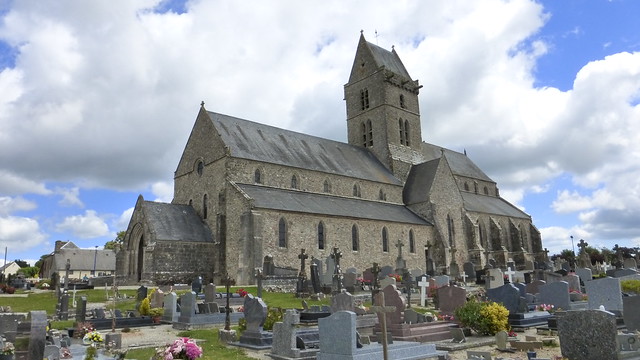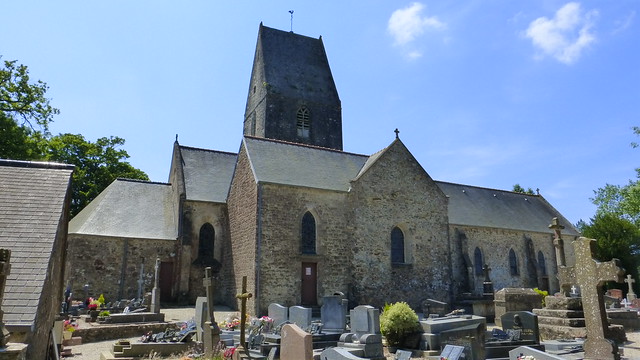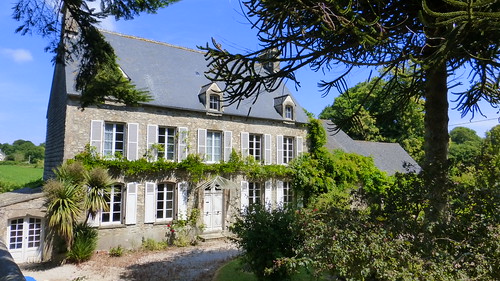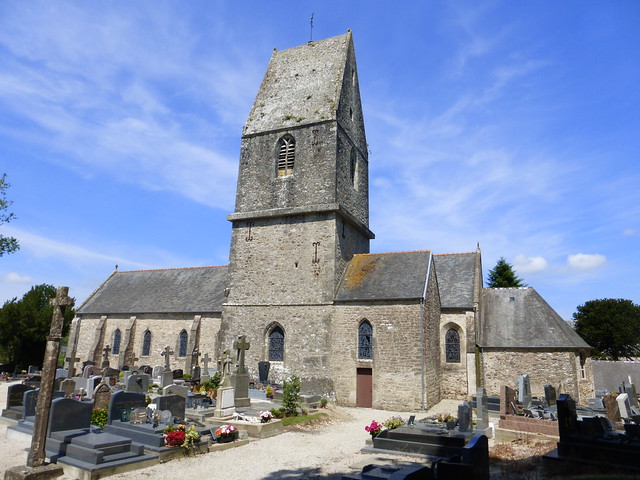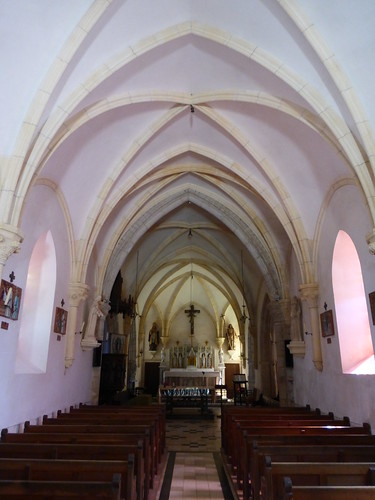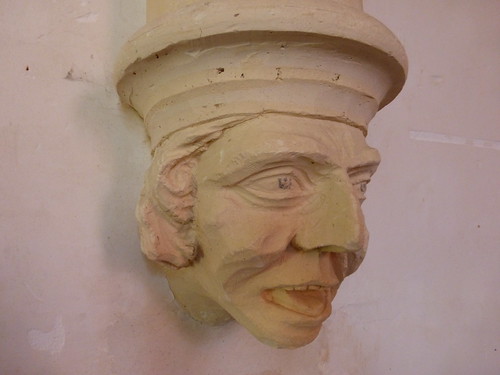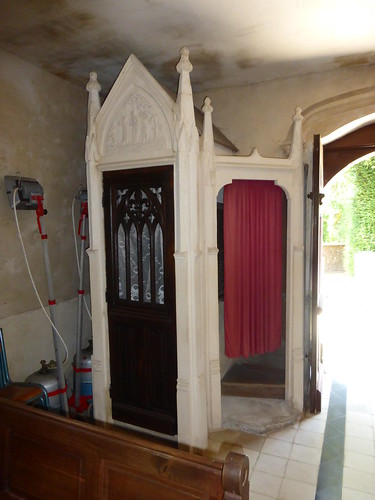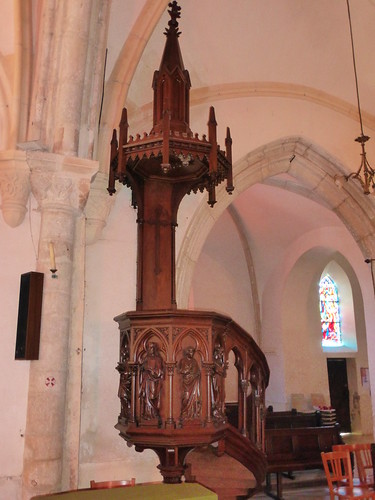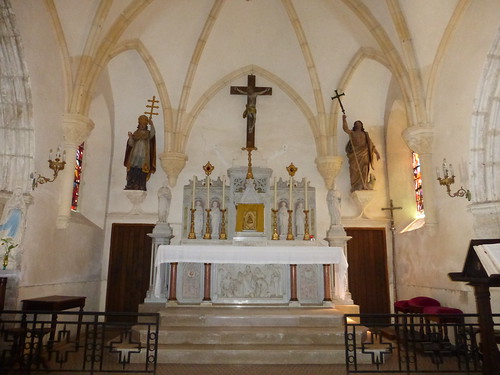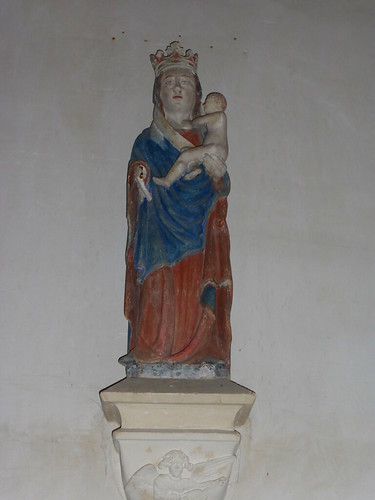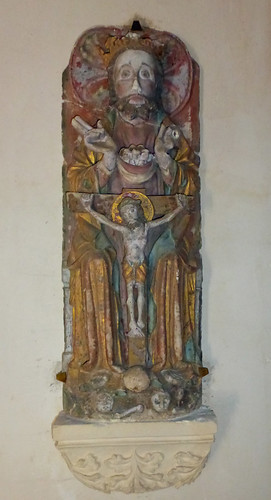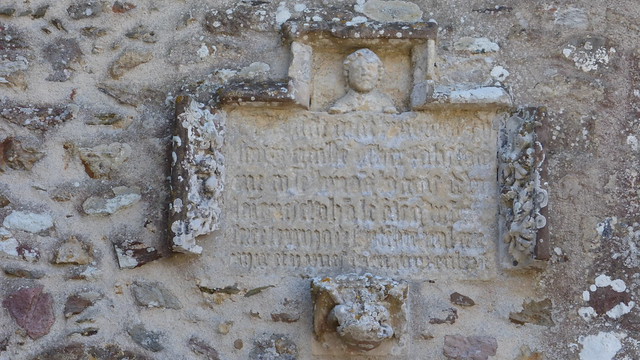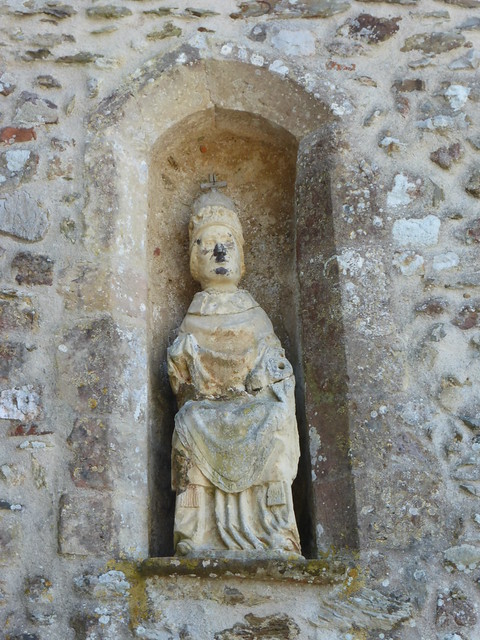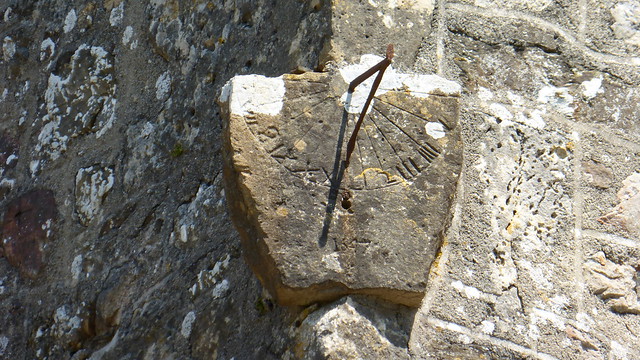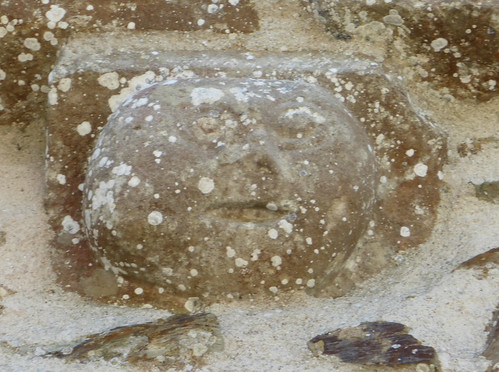July 19 2014
6
19
/07
/July
/2014
14:22
Published by The Baguette
-
in
Cotentin
July 19 2014
6
19
/07
/July
/2014
12:40
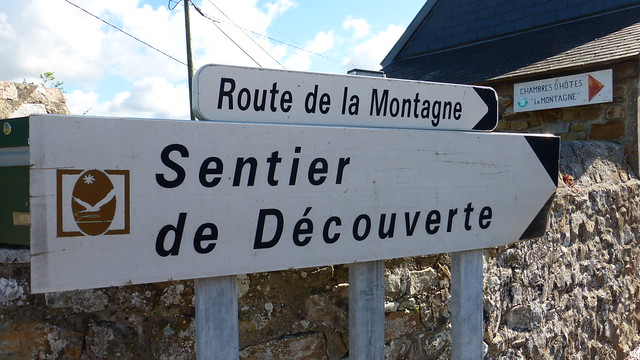
I went on yet another hike last weekend around Lessay which took me to several places of natural heritage including moors, forests, rivers and some charming little villages. To start, I had to park my car in the Fromagerie Réo parking lot and then find the signs that led to the sentiers de découverte of la Montagne. 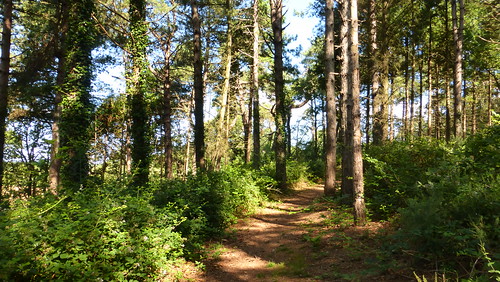


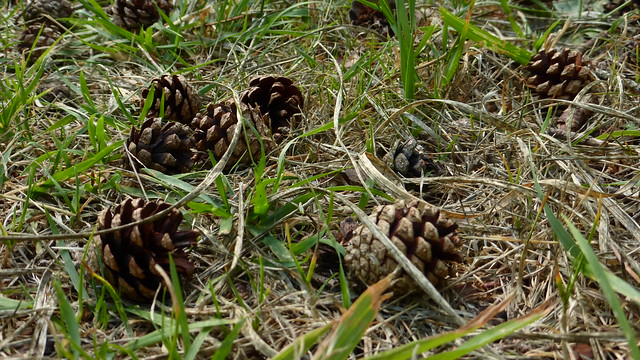 The best part of the entire walk is through this patch of pine forest which borders the Tourbière de Mathon, a peat bog or mire.
The best part of the entire walk is through this patch of pine forest which borders the Tourbière de Mathon, a peat bog or mire. 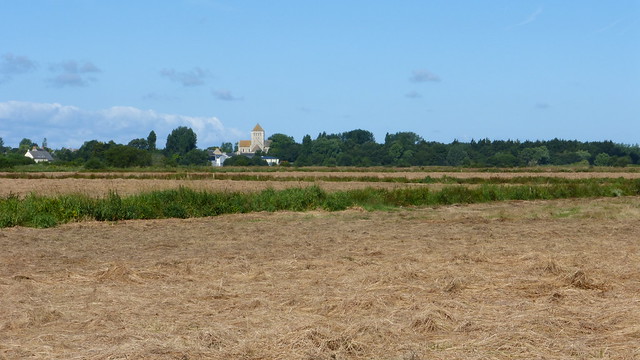 Across the tourbière you can see the abbey of Lessay in the distance.
Across the tourbière you can see the abbey of Lessay in the distance. 
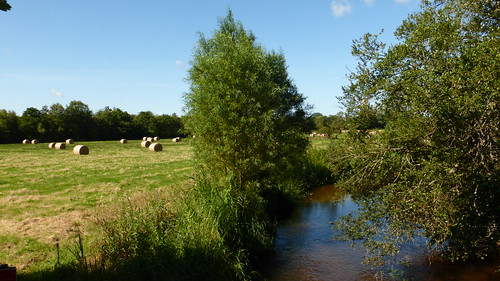 Parts of the walk take you across or along the coastal river of l’Ay which empties into the Channel only after flowing through Lessay and the great harbor of Saint-Germain-sur-Ay.
Parts of the walk take you across or along the coastal river of l’Ay which empties into the Channel only after flowing through Lessay and the great harbor of Saint-Germain-sur-Ay.  On July 29, 1944 American soldiers built a bridge over this river.
On July 29, 1944 American soldiers built a bridge over this river. 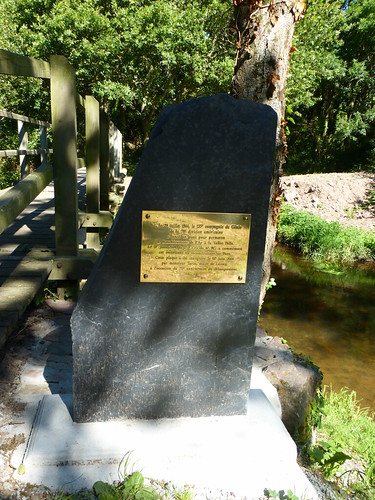 The bridge that exists here now is all that marks the spot except for a new memorial plaque which was erected here on June 7, 2014 to commemorate the D-Day landings.
The bridge that exists here now is all that marks the spot except for a new memorial plaque which was erected here on June 7, 2014 to commemorate the D-Day landings. 
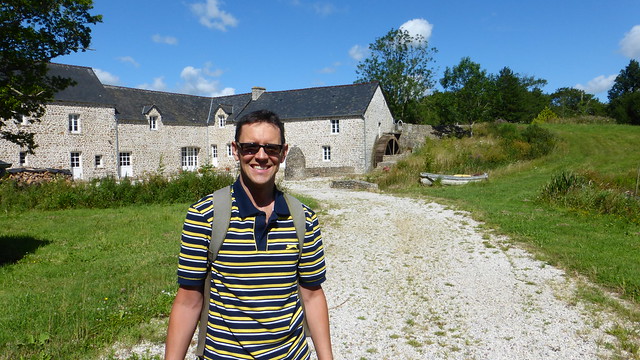
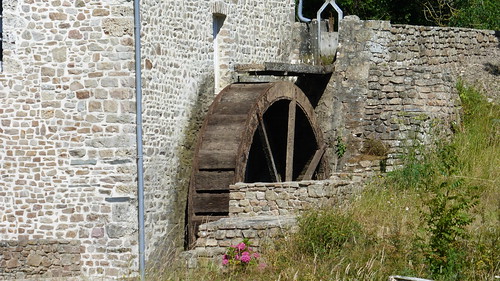
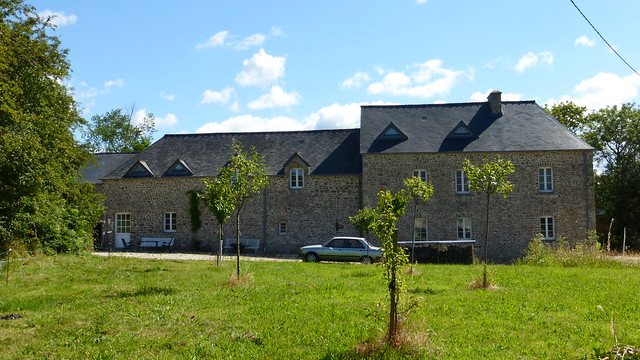 One of the places that the Manche tourism guide online says to see is the Moulin de Pissot in the village of Pissot. Unfortunately, their map and their directions are completely wrong. With a little effort on my own part before heading out, I was able to create my own map and had no problems finding the newly restored mill.
One of the places that the Manche tourism guide online says to see is the Moulin de Pissot in the village of Pissot. Unfortunately, their map and their directions are completely wrong. With a little effort on my own part before heading out, I was able to create my own map and had no problems finding the newly restored mill. 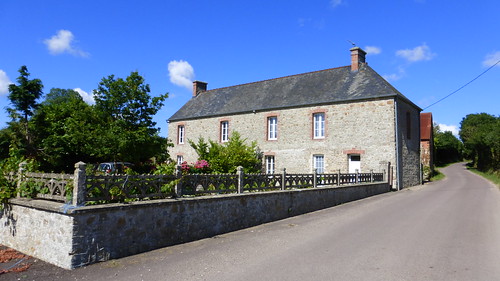
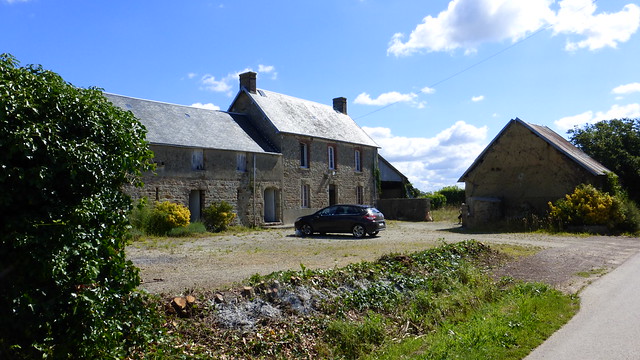

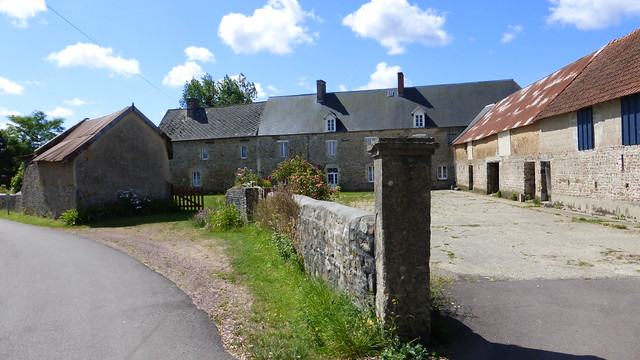 There are not many large mansions or castles to see along this hike but you can’t help finding some dignified farm houses along the way.
There are not many large mansions or castles to see along this hike but you can’t help finding some dignified farm houses along the way. 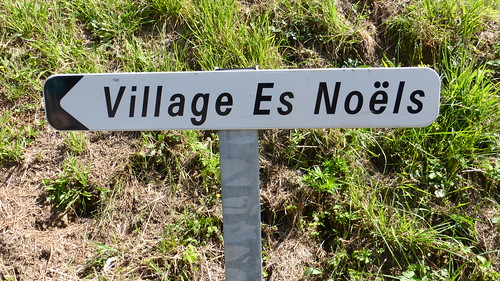

 On the way back, through the route de Renneville, I came across a small village made up of three or four houses which had the most appealing name: Village es Noëls which could probably mean the village of Noël or even the village at Christmas. Who knows ? I thought it was attractive.
On the way back, through the route de Renneville, I came across a small village made up of three or four houses which had the most appealing name: Village es Noëls which could probably mean the village of Noël or even the village at Christmas. Who knows ? I thought it was attractive. 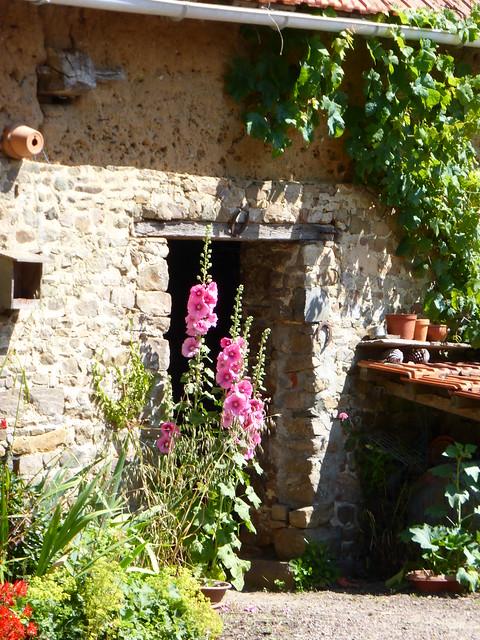
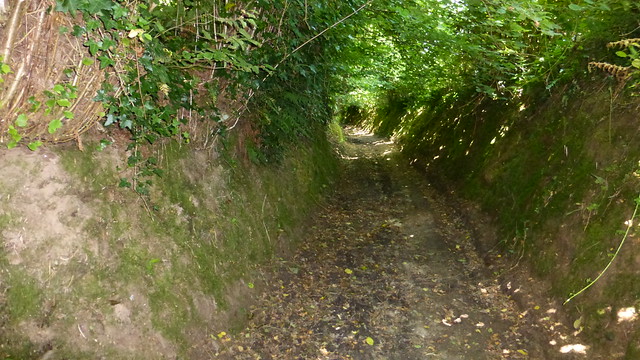
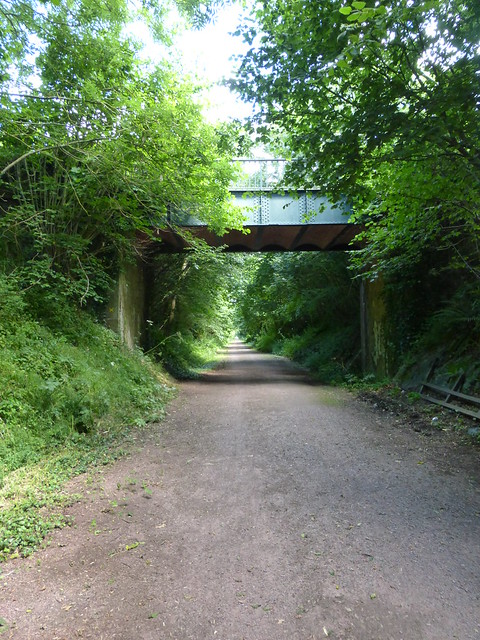 Past some more interesting houses and even a short stint through a covered hedgerow, I eventually came to the old railway line which once connected Coutances with Sottevast for over 100 years. It closed in 1984 and is now a green path between Cambernon and Rocheville (Bricquebec).
Past some more interesting houses and even a short stint through a covered hedgerow, I eventually came to the old railway line which once connected Coutances with Sottevast for over 100 years. It closed in 1984 and is now a green path between Cambernon and Rocheville (Bricquebec). 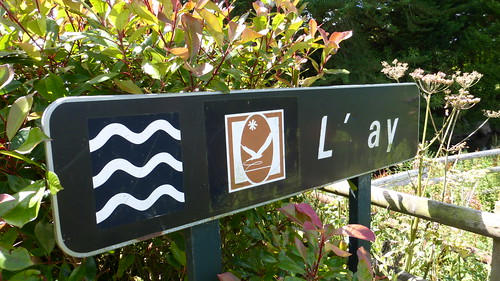
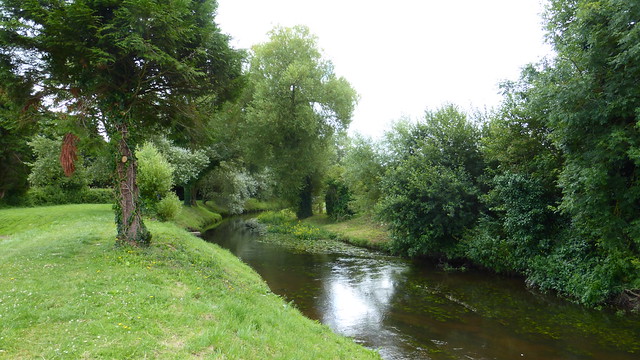 After getting back to town and following the River Ay, I took a much needed rest and ate my lunch in the shadow of the abbey. The Abbaye de Lessay is an 11th century Benedictine abbey that once flourished in Normandy. It has a rather ironic history in that it was one of the few monasteries that managed to stay perfectly preserved throughout the 18th and 19th centuries.
After getting back to town and following the River Ay, I took a much needed rest and ate my lunch in the shadow of the abbey. The Abbaye de Lessay is an 11th century Benedictine abbey that once flourished in Normandy. It has a rather ironic history in that it was one of the few monasteries that managed to stay perfectly preserved throughout the 18th and 19th centuries. 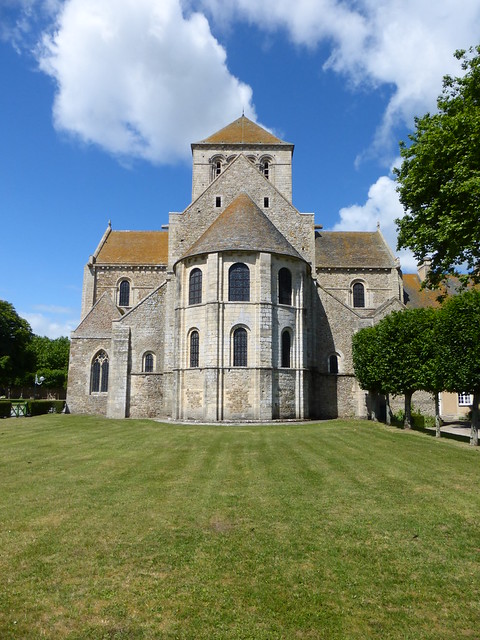
 Unfortunately, it was completely destroyed by retreating Germans on July 11, 1944 during World War II. In 1945 the abbey church and its former monastic buildings underwent a remarkable restoration carried out under the direction of Yves-Marie Froidevaux, Chief Architect of Historic Monuments, using archived material that was preserved in Paris. In 1958, the church opened again for services. Today, the monastery buildings are privately owned and not open to visitors. Every summer, concerts are held in the abbey.
Unfortunately, it was completely destroyed by retreating Germans on July 11, 1944 during World War II. In 1945 the abbey church and its former monastic buildings underwent a remarkable restoration carried out under the direction of Yves-Marie Froidevaux, Chief Architect of Historic Monuments, using archived material that was preserved in Paris. In 1958, the church opened again for services. Today, the monastery buildings are privately owned and not open to visitors. Every summer, concerts are held in the abbey.
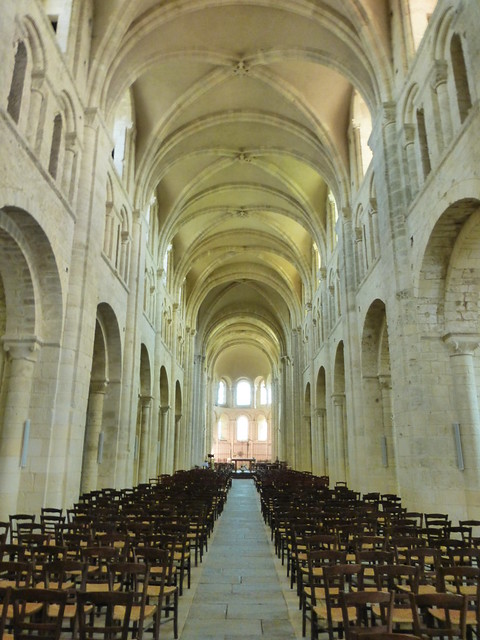
Published by The Baguette
-
in
Nature
July 17 2014
4
17
/07
/July
/2014
08:13

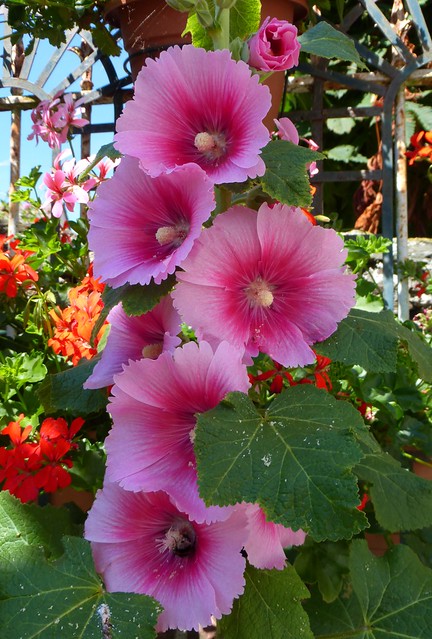 Just something different for a change... It seems like I'm always writing about churches and castles but failing to post anything else. A few years ago I planted some hollyhocks known as rose trémière in France and each year since, they've been coming back bigger and better. I tried growing some with different colors but haven't had much success. I wonder if anyone knows about trying to grow them indoors first and then transplanting them ?
Just something different for a change... It seems like I'm always writing about churches and castles but failing to post anything else. A few years ago I planted some hollyhocks known as rose trémière in France and each year since, they've been coming back bigger and better. I tried growing some with different colors but haven't had much success. I wonder if anyone knows about trying to grow them indoors first and then transplanting them ?
Published by The Baguette
-
in
Querqueville
July 16 2014
3
16
/07
/July
/2014
09:08
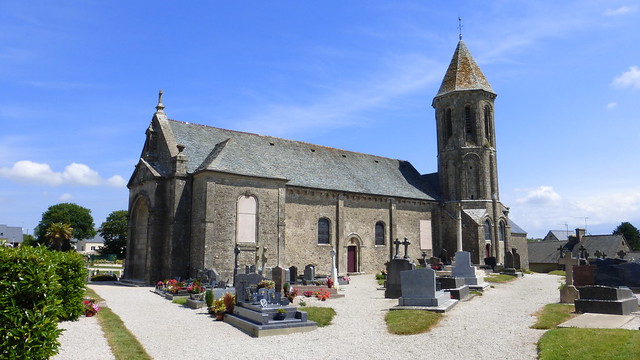
L'église Notre-Dame-de-l'Assomption is a 12th church in Tamerville dedicated to Our Lady. It has undergone many changes over the years and sadly, only the bell tower has retained its Romanesque style. A chapel dedicated to St. John the Baptist was originally built on the site before the 9th century but every vestige has long since disappeared. The construction of a new, larger building at the current location had to stop twice: during a famine in 820 and again in 838 with the arrival of the Normans who left only the tower standing. 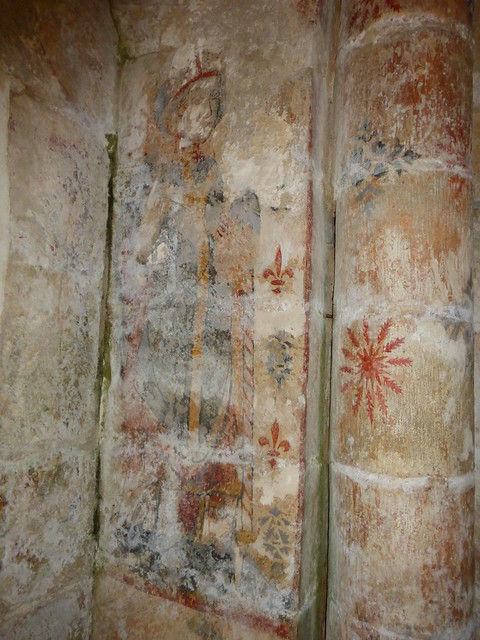 The present construction was initiated in 1070 by Geoffroy de Montbray, bishop of Coutances with the aid of a lord from Chiffrevast who returned to England several times to seek more workers and builders. Around 1420, Jacques d'Anneville, lord of Chiffrevast, added to the left of the choir a chapel to Saint-Jacques, whose purpose was to serve as his funeral chapel. This same chapel is now dedicated to St-Sulpice.
The present construction was initiated in 1070 by Geoffroy de Montbray, bishop of Coutances with the aid of a lord from Chiffrevast who returned to England several times to seek more workers and builders. Around 1420, Jacques d'Anneville, lord of Chiffrevast, added to the left of the choir a chapel to Saint-Jacques, whose purpose was to serve as his funeral chapel. This same chapel is now dedicated to St-Sulpice. 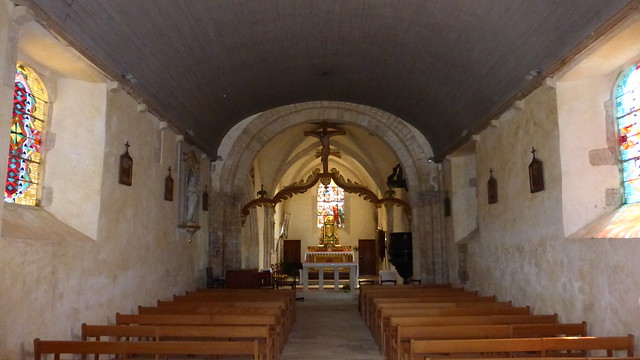 In the 15th century, alterations were made especially on the choir (ribbed vaulting added) and chevet. In the 17th century modifications to the nave were undertaken by extending one bay and enlarging several windows.
In the 15th century, alterations were made especially on the choir (ribbed vaulting added) and chevet. In the 17th century modifications to the nave were undertaken by extending one bay and enlarging several windows. 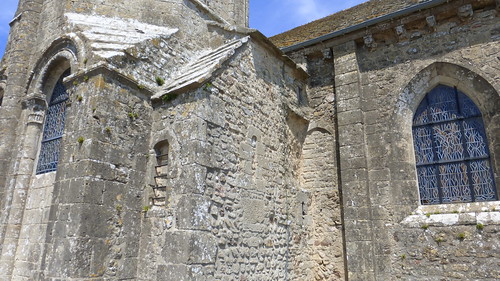 On the exterior north façade one can see remnants of Romanesque windows now blocked.
On the exterior north façade one can see remnants of Romanesque windows now blocked. 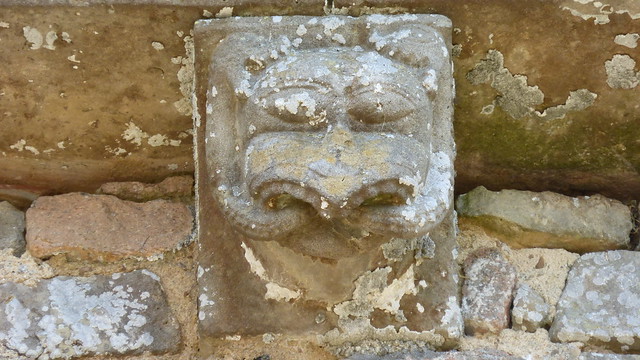
 The cornices of the nave and the choir maintain over sixty Romanesque corbels of grotesque faces.
The cornices of the nave and the choir maintain over sixty Romanesque corbels of grotesque faces.  In 1672, access to the Saint-Jacques chapel was created by knocking down part of the wall in the transept and creating a pointed arch--remains of a window can be seen at the top.
In 1672, access to the Saint-Jacques chapel was created by knocking down part of the wall in the transept and creating a pointed arch--remains of a window can be seen at the top. 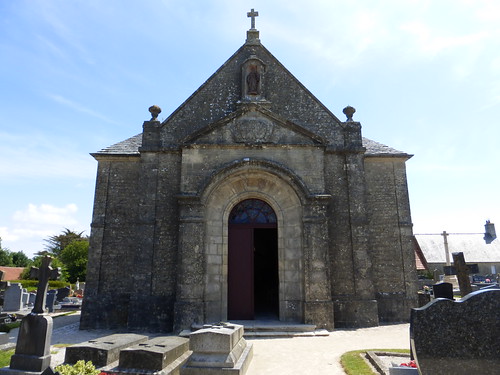 In 1755, the western portal was installed and topped by a triangular pediment and surmounted by a niche with the cast iron statue of Saint Mayeul.
In 1755, the western portal was installed and topped by a triangular pediment and surmounted by a niche with the cast iron statue of Saint Mayeul. 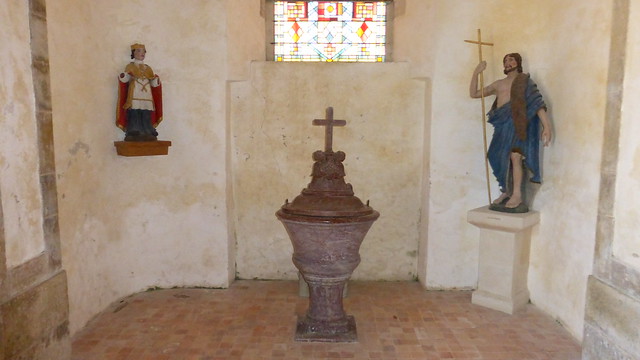 The ceiling was redone with wood in 1813 and two small side chapels along the nave (one of which holds the baptismal font) were created in 1855.
The ceiling was redone with wood in 1813 and two small side chapels along the nave (one of which holds the baptismal font) were created in 1855. 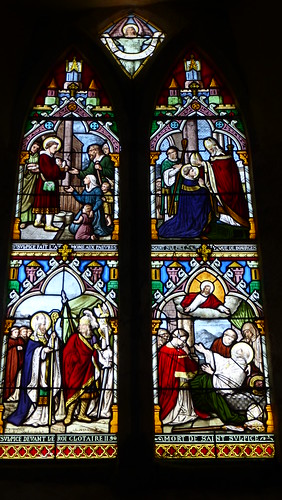 A stained glass window in the Saint-Sulpice chapel recounts the life of St-Sulpice, a 7th century bishop of Bourges whose reliquary would have been shared between this church and the one in Fresville.
A stained glass window in the Saint-Sulpice chapel recounts the life of St-Sulpice, a 7th century bishop of Bourges whose reliquary would have been shared between this church and the one in Fresville. 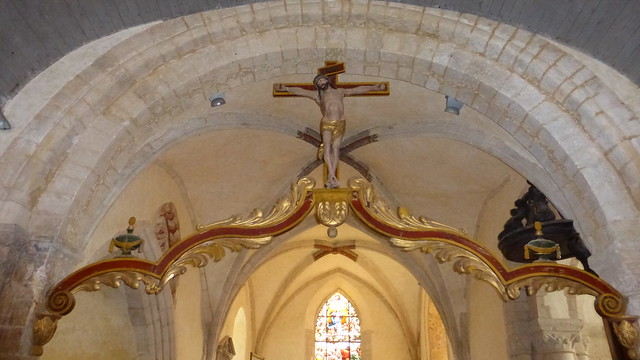
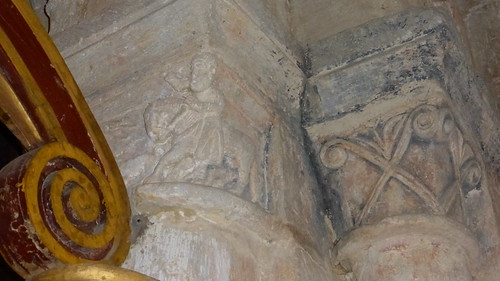 To the right of the rood beam on one of the capitals of the triumphal arch is the image of Saint-Hubert hunting a deer. Many elements of church furniture are classified as historical monuments:
To the right of the rood beam on one of the capitals of the triumphal arch is the image of Saint-Hubert hunting a deer. Many elements of church furniture are classified as historical monuments: 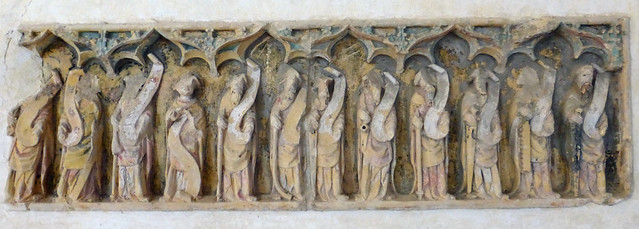 To the right of the main altar, a very damaged colored limestone bas-relief from early 16th century representing the twelve apostles.
To the right of the main altar, a very damaged colored limestone bas-relief from early 16th century representing the twelve apostles. 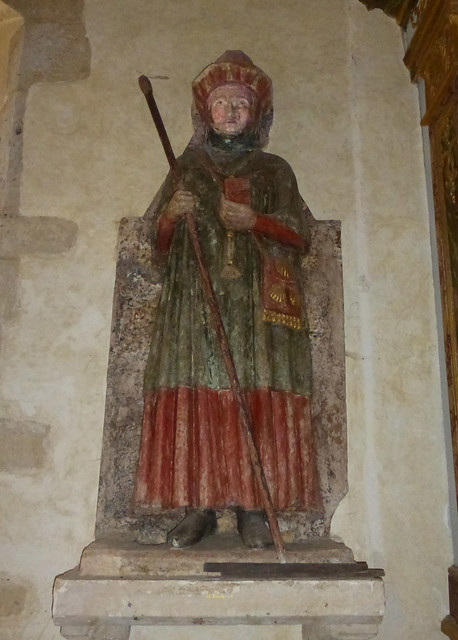 In the chapel of Saint-Sulpice, a high-relief statue depicting St-Jacques (with a staff in his right hand) in polychrome limestone from the 14th century.
In the chapel of Saint-Sulpice, a high-relief statue depicting St-Jacques (with a staff in his right hand) in polychrome limestone from the 14th century. 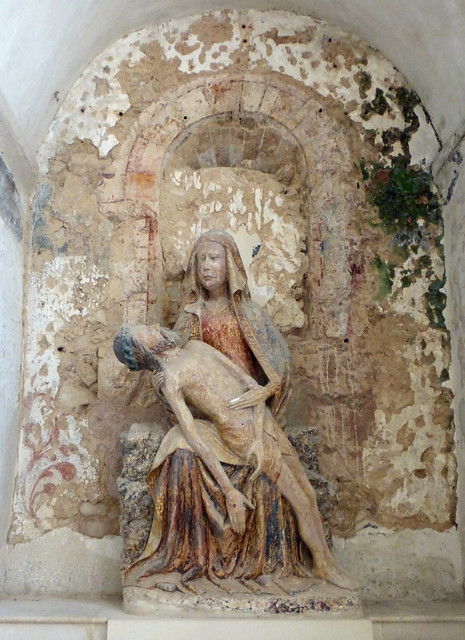 In the chapel underneath the 11th century bell tower is a 15th century Pietà in polychrome limestone.
In the chapel underneath the 11th century bell tower is a 15th century Pietà in polychrome limestone. 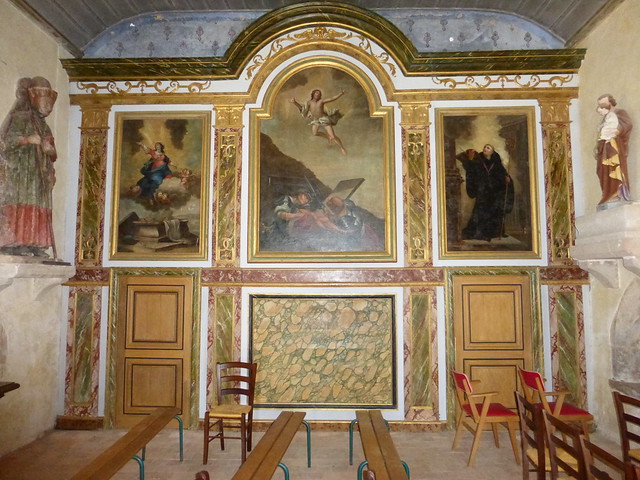 The side altar in the Saint-Sulpice chapel is painted in trompe-l'oeil and comes from the second half of the 18th. Its paintings represent the Assumption of the Virgin, the Resurrection of Christ and Saint Benedict. Very little information is given about the many remains of frescoes throughout the church. One can only imagine they are very old.
The side altar in the Saint-Sulpice chapel is painted in trompe-l'oeil and comes from the second half of the 18th. Its paintings represent the Assumption of the Virgin, the Resurrection of Christ and Saint Benedict. Very little information is given about the many remains of frescoes throughout the church. One can only imagine they are very old.
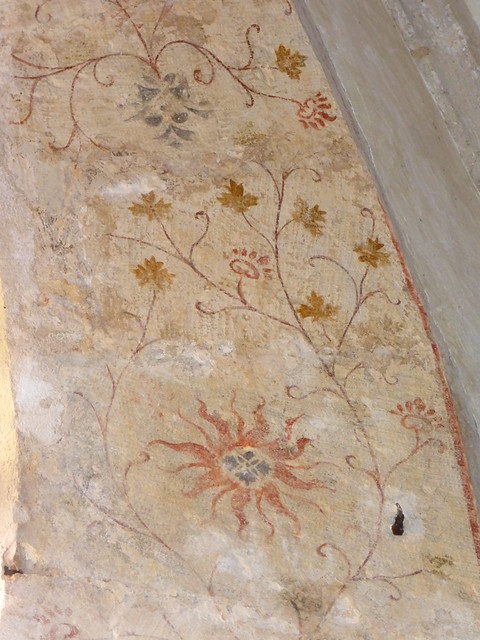
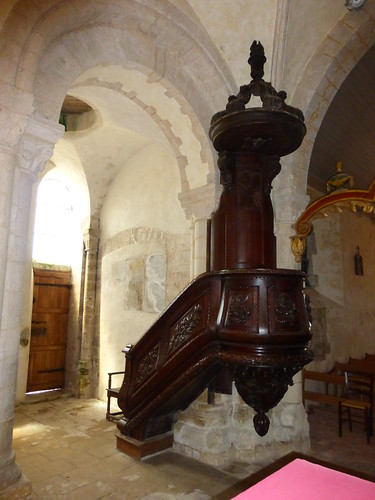
 Other interesting pieces of furniture include a carved pulpit and a very colorful high altar. There are some interesting (if not dirty) memorial inscriptions in the chapel below the bell tower. They are very difficult to read since they are written in Old French and Latin.
Other interesting pieces of furniture include a carved pulpit and a very colorful high altar. There are some interesting (if not dirty) memorial inscriptions in the chapel below the bell tower. They are very difficult to read since they are written in Old French and Latin.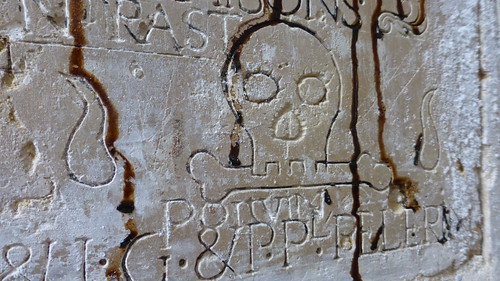

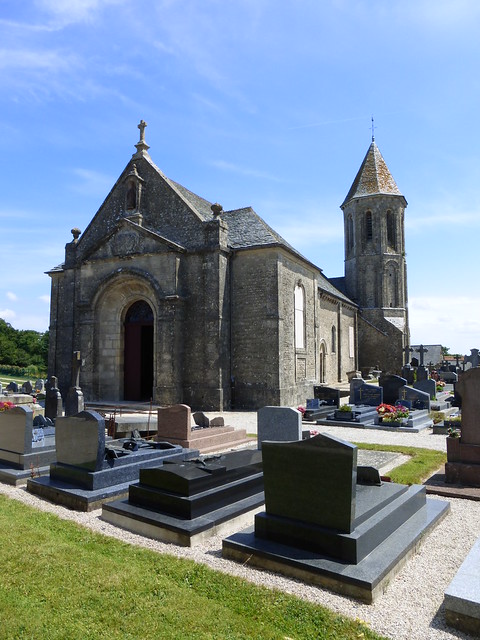
Published by The Baguette
-
in
Cultural Heritage
July 13 2014
7
13
/07
/July
/2014
13:42
Published by The Baguette
-
in
Cotentin
July 13 2014
7
13
/07
/July
/2014
12:09
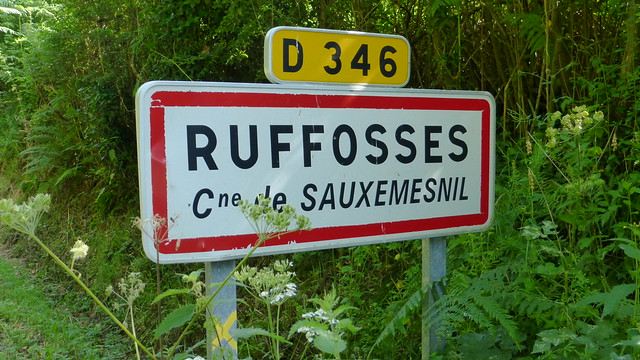
Once again, we’ve been having really nice weather in la Manche. When it’s like this, you can’t help but go outside and do something—head to the beach, ride your bike or take a nice long walk. Fortunately for me, I’ve been able to do all these things in abundance. Yesterday, I did the “Promenade et Randonnée Autour de Rochemont” which takes you through some very pretty woodlands around the village of Ruffosses, a community belonging to the small town of Saussemesnil (sometimes spelled, Sauxemesnil). 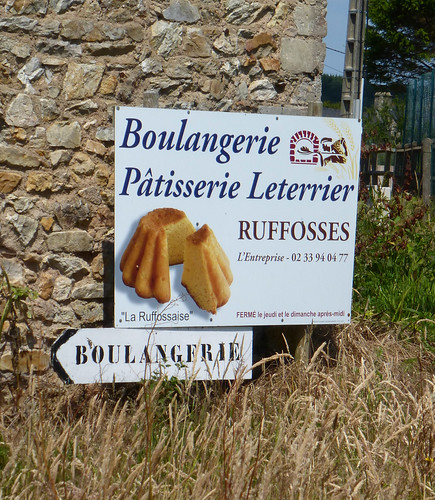
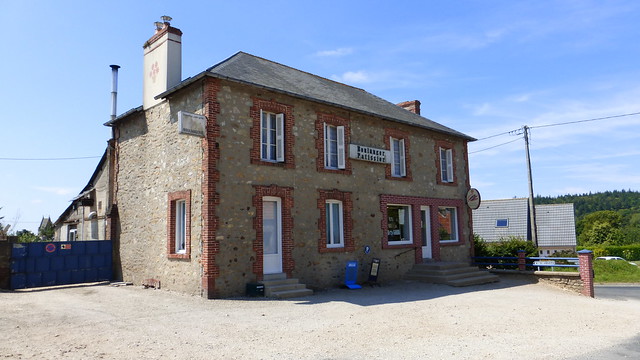 The hike begins from a parking lot near the Boulangerie Pâtisserie Leterrier and takes you first past the Église Notre-Dame-des-Anges.
The hike begins from a parking lot near the Boulangerie Pâtisserie Leterrier and takes you first past the Église Notre-Dame-des-Anges. 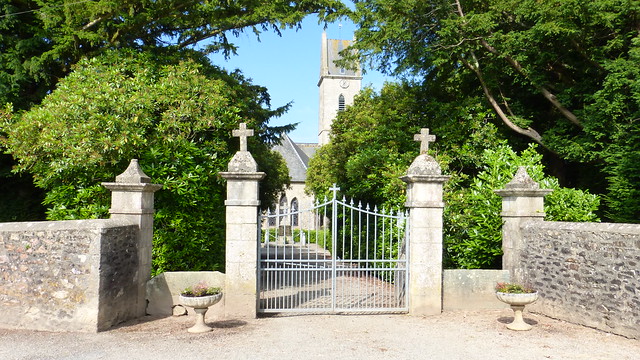 There is a sign posted at the entrance that says, “By order of the mayor, the doors of this church must remain open every day.” They were closed and I was unable to go inside. An elderly man with a thick Norman accent, attending to some graves, said that it was probably too early and that it should be open later. It wasn’t. I came back after the hike and it was still locked. Oh well. As with more than a thousand churches in Normandy, the church in Ruffosses is devoted to the Virgin Mary. Before the mid-nineteenth century, the oldest religious building of Ruffosses was the Chapel of Our Lady of Deliverance which was erected by sailors in the 17th century. It was used as a place of pilgrimage for sailors until 1851, abandoned and condemned by 1853 and eventually sold.
There is a sign posted at the entrance that says, “By order of the mayor, the doors of this church must remain open every day.” They were closed and I was unable to go inside. An elderly man with a thick Norman accent, attending to some graves, said that it was probably too early and that it should be open later. It wasn’t. I came back after the hike and it was still locked. Oh well. As with more than a thousand churches in Normandy, the church in Ruffosses is devoted to the Virgin Mary. Before the mid-nineteenth century, the oldest religious building of Ruffosses was the Chapel of Our Lady of Deliverance which was erected by sailors in the 17th century. It was used as a place of pilgrimage for sailors until 1851, abandoned and condemned by 1853 and eventually sold. 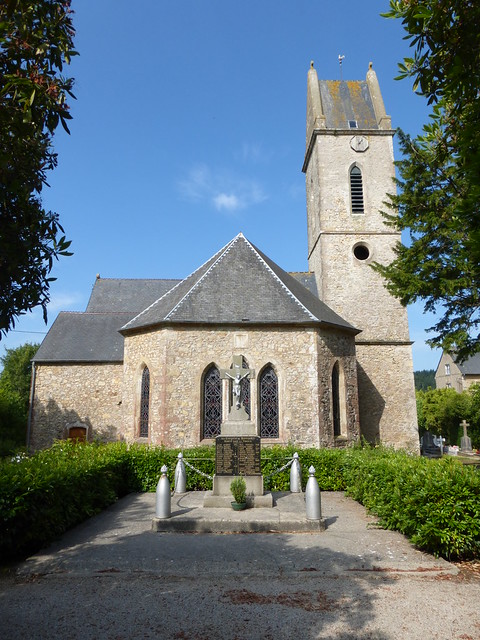 In 1854, Mme Féline de Montdésir, née Sivard de Beaulieu donated money to have a new church completed on the site. It was surrounded by a cemetery and meditation garden of exotic plants, rhododendrons and bamboo which still exist to this day. The church was bombed in 1944 and the vault collapsed in 1947 but was restored in the neo-Gothic style during the 1950s.
In 1854, Mme Féline de Montdésir, née Sivard de Beaulieu donated money to have a new church completed on the site. It was surrounded by a cemetery and meditation garden of exotic plants, rhododendrons and bamboo which still exist to this day. The church was bombed in 1944 and the vault collapsed in 1947 but was restored in the neo-Gothic style during the 1950s. 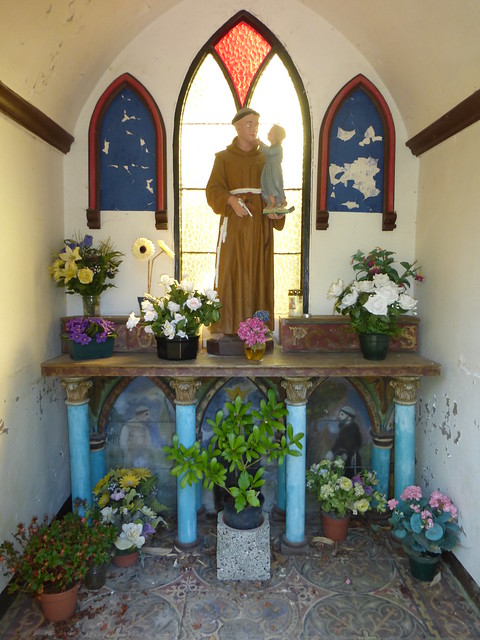 Before you leave, don’t forget to see this small chapel on the grounds devoted to Saint Anthony.
Before you leave, don’t forget to see this small chapel on the grounds devoted to Saint Anthony. 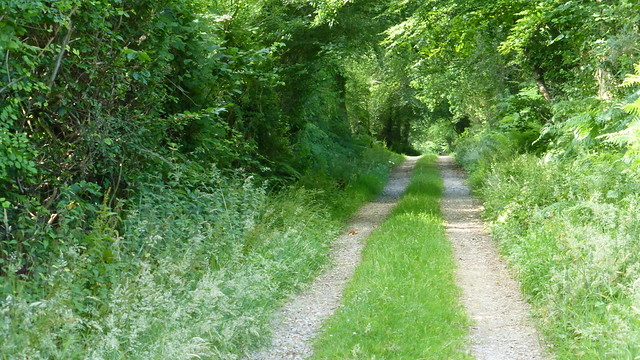 The hiking path is quite flat and very easy to follow if you keep to the marked trail which follows several small farm roads and some overgrown paths covered so thickly with trees, it appears that you’re walking through a dimly lit cave at times.
The hiking path is quite flat and very easy to follow if you keep to the marked trail which follows several small farm roads and some overgrown paths covered so thickly with trees, it appears that you’re walking through a dimly lit cave at times. 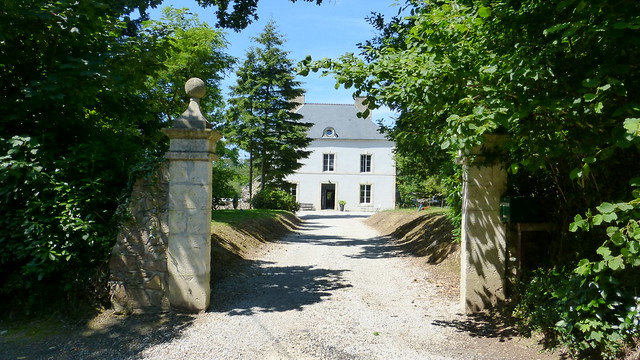 There are also several nice houses to see along the way including this one just to the left of the church.
There are also several nice houses to see along the way including this one just to the left of the church. 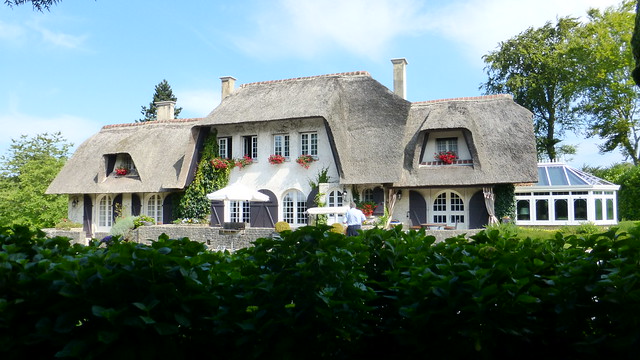 Along one street called la Fosse Lonlay you come across this beautiful house with a thatched roof.
Along one street called la Fosse Lonlay you come across this beautiful house with a thatched roof. 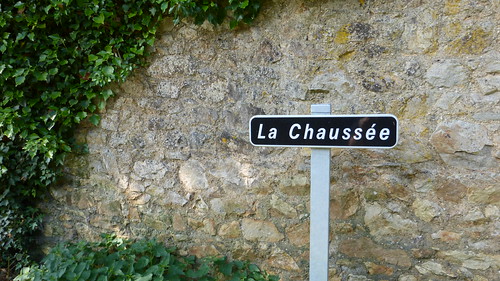
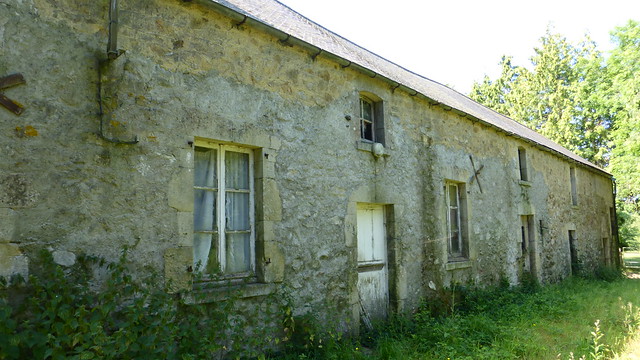 Later on, past some apple orchards you come to a place called Ferme de la Chaussée with a rundown farm which is in need of repair. I don’t think that will be a problem since most “Norman peasant” farms are being quickly bought up by the rich and turned into holiday cottages.
Later on, past some apple orchards you come to a place called Ferme de la Chaussée with a rundown farm which is in need of repair. I don’t think that will be a problem since most “Norman peasant” farms are being quickly bought up by the rich and turned into holiday cottages. 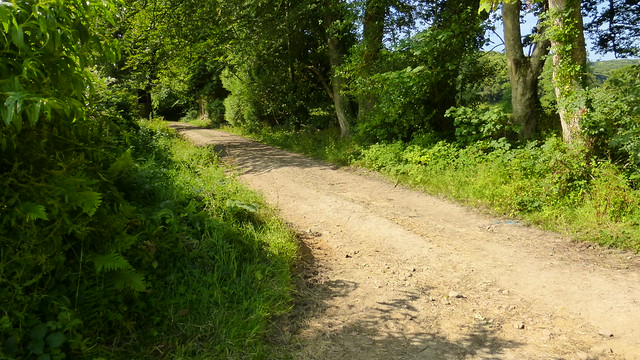 Even though this dirt road looks like any other dirt road in Normandy, it is actually the remains of the old Roman Way or Voie gallo-romaine. Le bois de l'Etot Rouge belongs to one of the most beautiful sets of woods in the Cotentin.
Even though this dirt road looks like any other dirt road in Normandy, it is actually the remains of the old Roman Way or Voie gallo-romaine. Le bois de l'Etot Rouge belongs to one of the most beautiful sets of woods in the Cotentin.  It was formerly part of the great forest of Brix, which occupied more than 7,000 hectares in the 17th century.
It was formerly part of the great forest of Brix, which occupied more than 7,000 hectares in the 17th century. 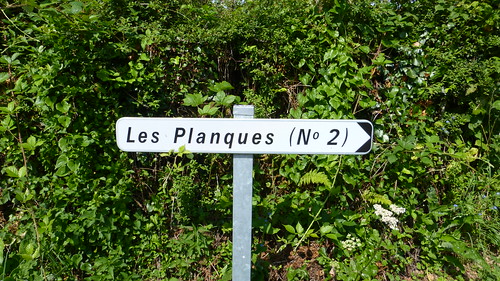
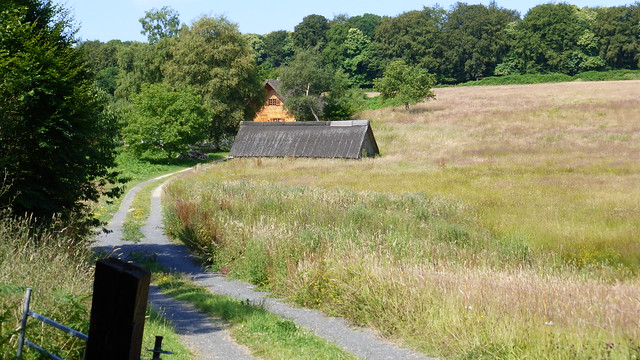
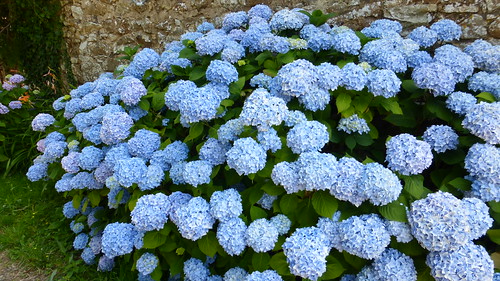
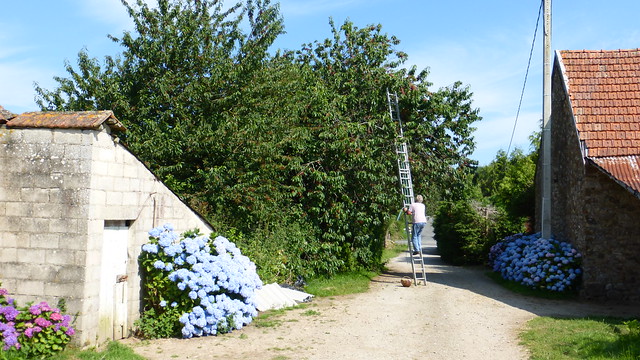 Along another small road called Les Planques I came across a man harvesting cherries from his trees. His house was surrounded by hydrangeas of every color. There is only one stream that you cross along the course of the hike and that takes you over the Rivire de Gloire.
Along another small road called Les Planques I came across a man harvesting cherries from his trees. His house was surrounded by hydrangeas of every color. There is only one stream that you cross along the course of the hike and that takes you over the Rivire de Gloire. 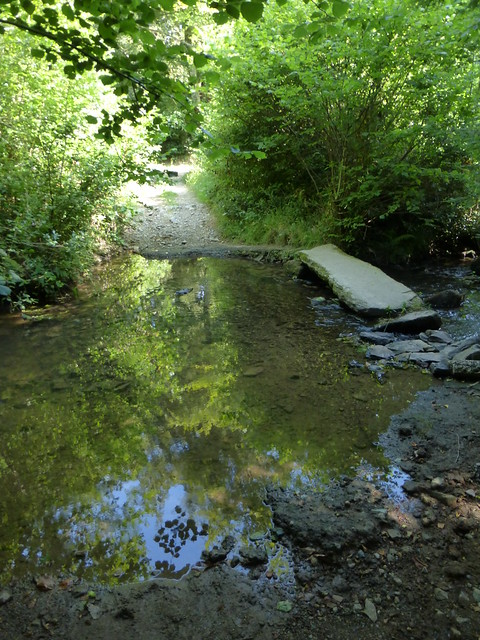
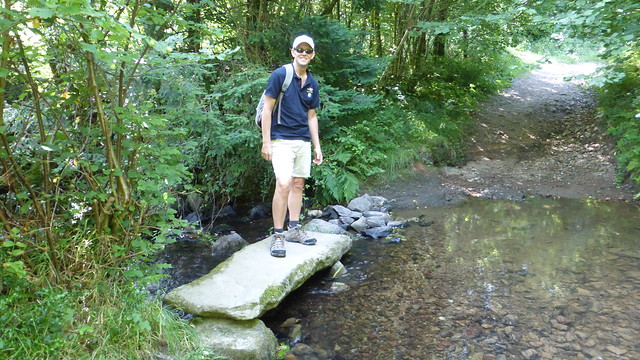 It is crossed by a ford of flat stones called Gué à pierres plates.
It is crossed by a ford of flat stones called Gué à pierres plates. 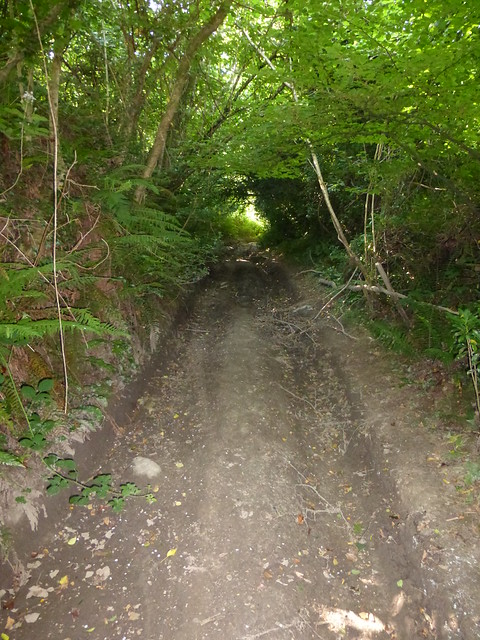
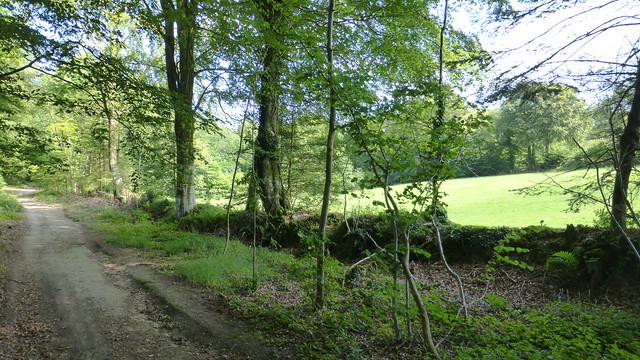

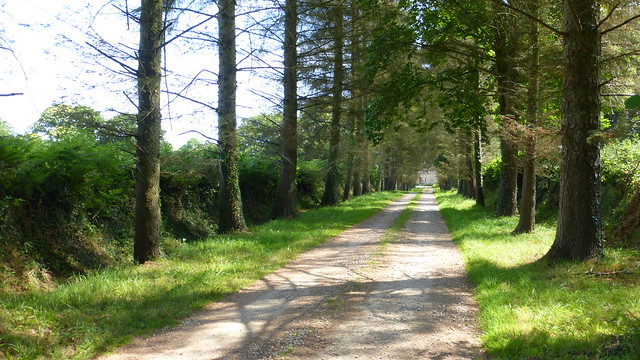
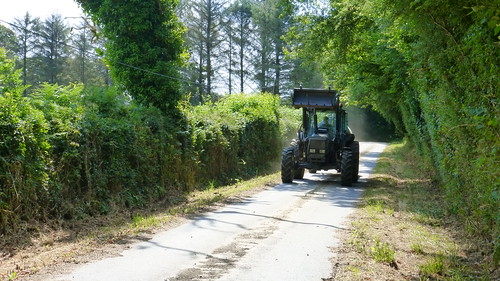 Past fields planted with corn, through country lanes lined with tall trees and through thick underbrush you'll eventually come back to this waterway again which joins les étangs de Roudoux (a series of two large ponds) within a beautiful valley.
Past fields planted with corn, through country lanes lined with tall trees and through thick underbrush you'll eventually come back to this waterway again which joins les étangs de Roudoux (a series of two large ponds) within a beautiful valley. 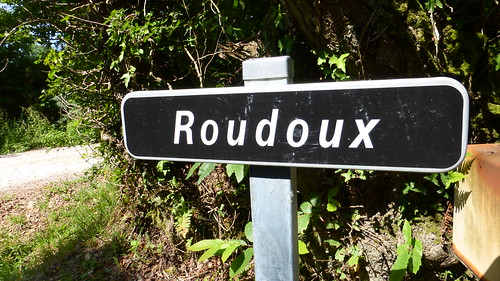
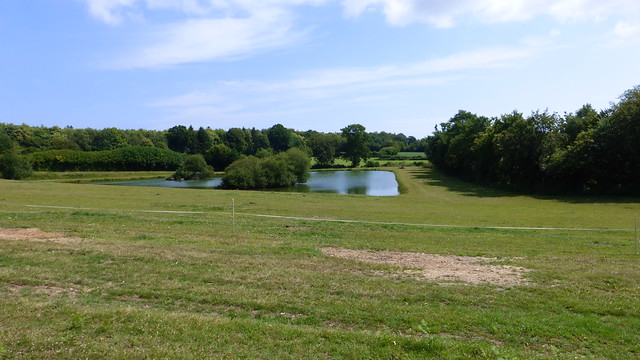
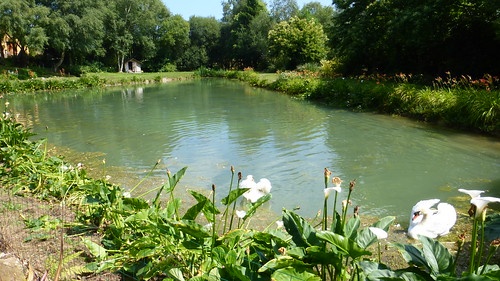 The two ponds are located on private property and until recently they were open to visitors for water recreation activities. Unfortunately, this is no longer the case as the sign posted on the gate reads:
The two ponds are located on private property and until recently they were open to visitors for water recreation activities. Unfortunately, this is no longer the case as the sign posted on the gate reads: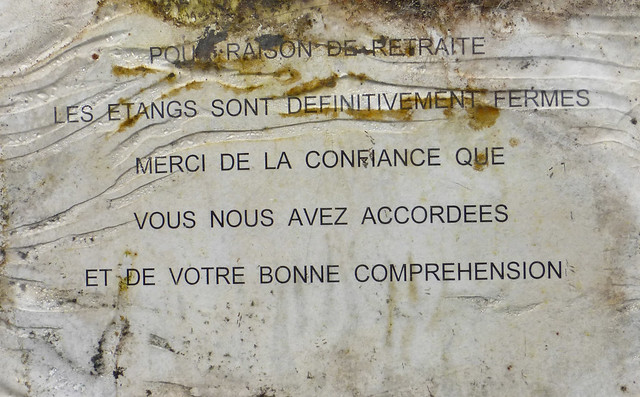
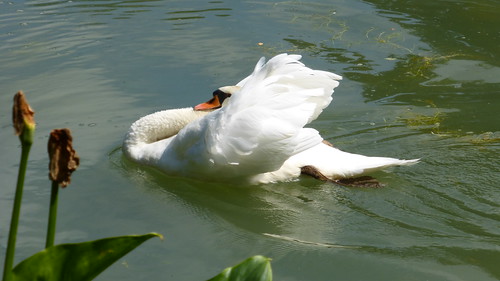
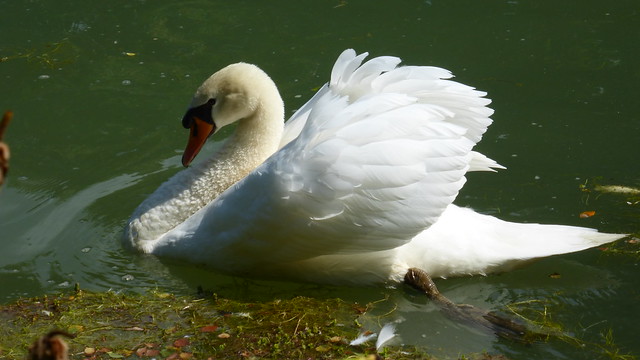 The smaller of the two lakes is still open to the public and has two large swans to entertain you. The last stretch of the hike takes you past the farm and the Château de Rochemont from whence this hike gets its name.
The smaller of the two lakes is still open to the public and has two large swans to entertain you. The last stretch of the hike takes you past the farm and the Château de Rochemont from whence this hike gets its name. 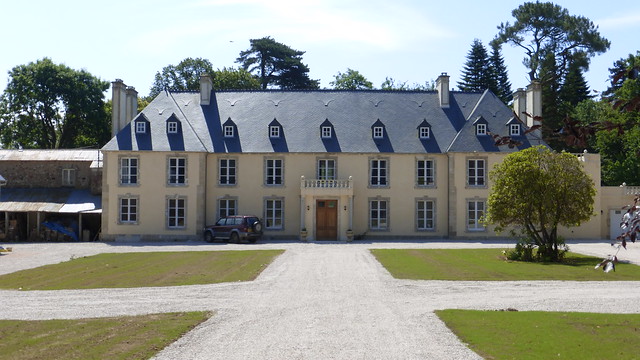 It was built in the late 18th century by ancestors of the De Mondesir family, who managed to hold onto their property despite the French Revolution due to their support for it.
It was built in the late 18th century by ancestors of the De Mondesir family, who managed to hold onto their property despite the French Revolution due to their support for it. 
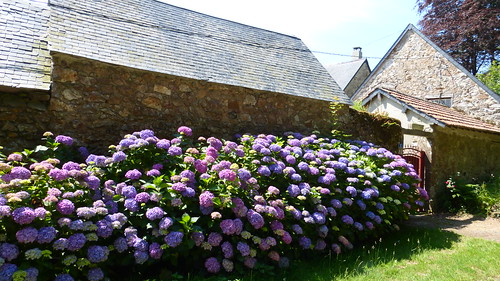
 The outbuildings and nearby farm house are lined with more hydrangeas in nearly every shade of blue you can think of.
The outbuildings and nearby farm house are lined with more hydrangeas in nearly every shade of blue you can think of.  There are a number of lovely houses along the route as well including this charming little cottage with its appealing gardens. Are you interested in owning your own little castle or manor house ?
There are a number of lovely houses along the route as well including this charming little cottage with its appealing gardens. Are you interested in owning your own little castle or manor house ?  This one is located just beside the church and is currently for sale.
This one is located just beside the church and is currently for sale.
Published by The Baguette
-
in
Cotentin
July 2 2014
3
02
/07
/July
/2014
12:05
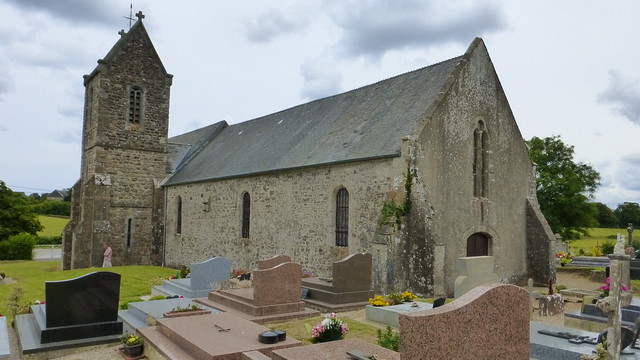
The Église Sainte-Colombe de Crasville is very old and can be dated as far back as the 12th century when it was consecrated by Richard de Bohon, Bishop of Coutances in 1154 under the patronage of the Abbey of Montebourg. It is composed of a choir and nave and lacks a transept. In its present form, it dates from the 17th and 18th century—the only medieval element remaining is the triumphal arch between the chancel and the nave. The bell tower was rebuilt in 1674 and rebuilt again in 1920. The sacristy can be dated to exactly 1722. 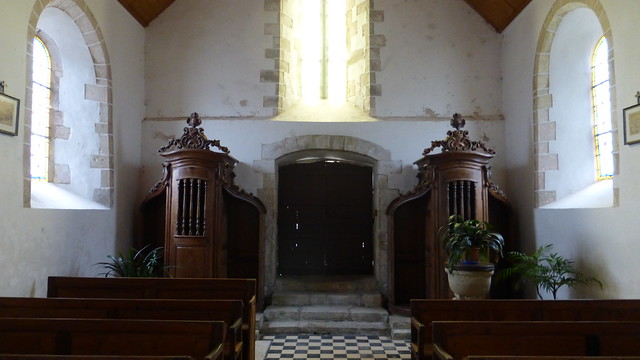
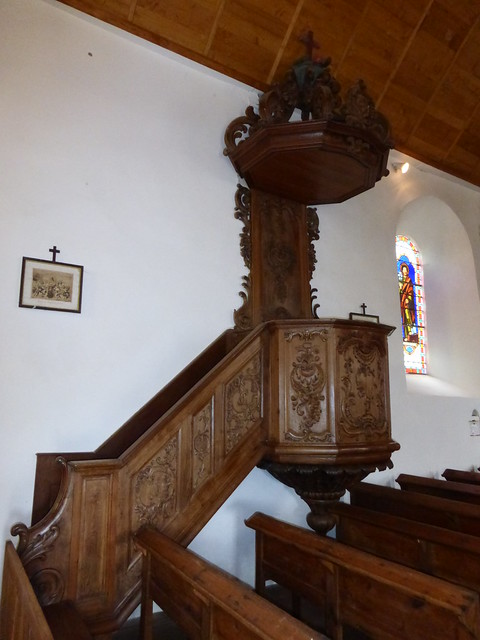 The value of this church is not its architecture, but by its rich furnishings, a nearly perfect homogeneous grouping of altarpieces, doorways to the sacristy, a rood screen, pulpit, lectern, stools, benches and confessionals.
The value of this church is not its architecture, but by its rich furnishings, a nearly perfect homogeneous grouping of altarpieces, doorways to the sacristy, a rood screen, pulpit, lectern, stools, benches and confessionals. 
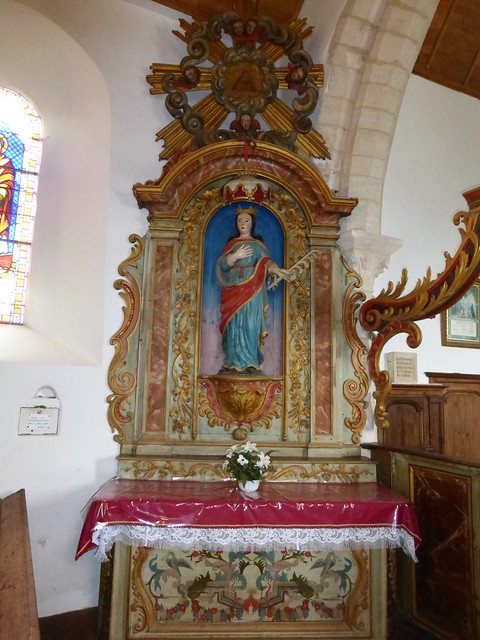
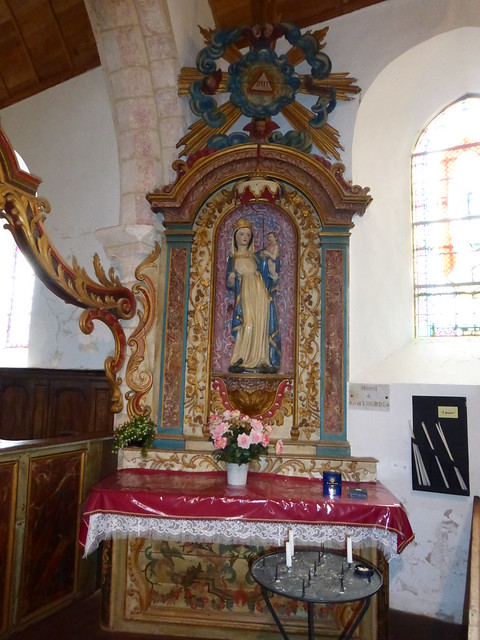 Some pieces are dated with precision: the stalls and the seat for the celebrant date from 1766, the crucifix from 1767 and the confessionals from 1769. What is more fascinating is that all of this liturgical furniture owes its existence to the savings of a small country priest as well as the disinterestedness of a carpenter, Guillaume Godefroy who worked for years at prices far below normal for the time.
Some pieces are dated with precision: the stalls and the seat for the celebrant date from 1766, the crucifix from 1767 and the confessionals from 1769. What is more fascinating is that all of this liturgical furniture owes its existence to the savings of a small country priest as well as the disinterestedness of a carpenter, Guillaume Godefroy who worked for years at prices far below normal for the time.  The central panel of the altarpiece represents the Adoration of the Magi.
The central panel of the altarpiece represents the Adoration of the Magi. 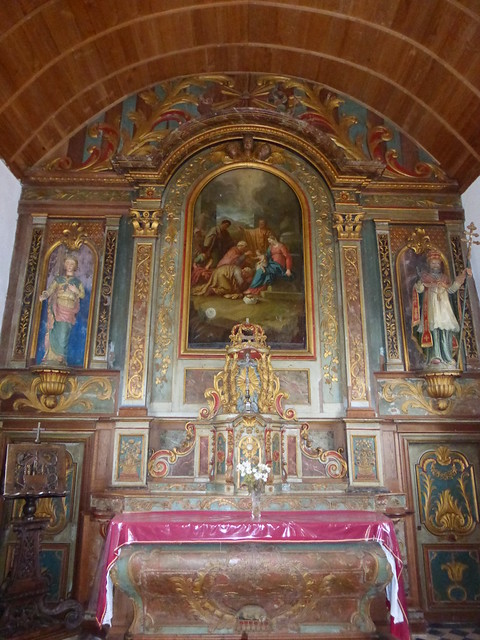 Local flavor is given by the terracotta statues from Sauxemesnil of Sainte-Colombe and Saint-Gregory placed in niches on either side of the altar. Another statue of clay, that of Ste-Catherine, adorns the altar of the small altar to the left. The only medieval church statue is a limestone Madonna and Child from the 14th century located in the southern side altar.
Local flavor is given by the terracotta statues from Sauxemesnil of Sainte-Colombe and Saint-Gregory placed in niches on either side of the altar. Another statue of clay, that of Ste-Catherine, adorns the altar of the small altar to the left. The only medieval church statue is a limestone Madonna and Child from the 14th century located in the southern side altar. 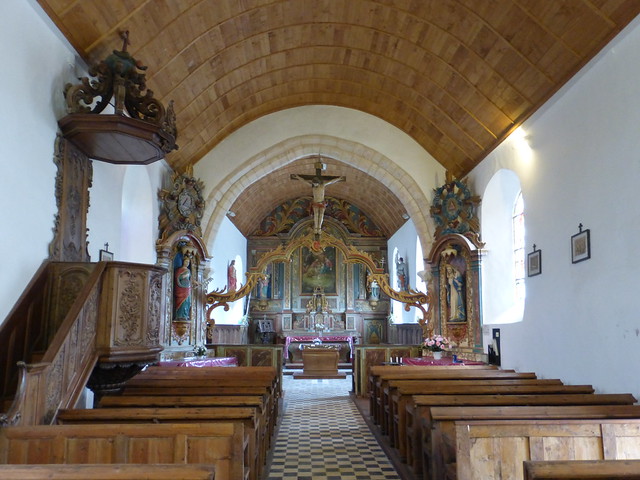 It is said that during the Revolution, officials ordered some men to remove the furniture. They wanted to remove the crucifix of the great rood screen in the nave but found it very difficult. Robert Pilet, faithless man, said, "Wait, let me do it my way." Whereupon he threw a rope over the head of Christ and pulled with all his strength. A man of faith named Nicolas Lequertier, came over to him and intervened saying, "Get away from there or I’ll cut your neck with my own axe!” The Christ remained.
It is said that during the Revolution, officials ordered some men to remove the furniture. They wanted to remove the crucifix of the great rood screen in the nave but found it very difficult. Robert Pilet, faithless man, said, "Wait, let me do it my way." Whereupon he threw a rope over the head of Christ and pulled with all his strength. A man of faith named Nicolas Lequertier, came over to him and intervened saying, "Get away from there or I’ll cut your neck with my own axe!” The Christ remained. 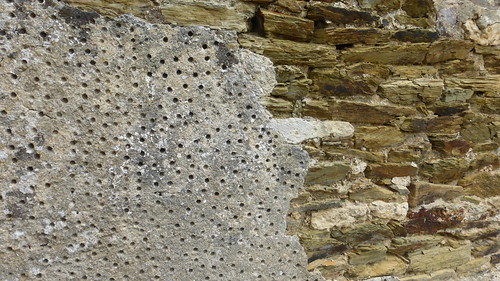
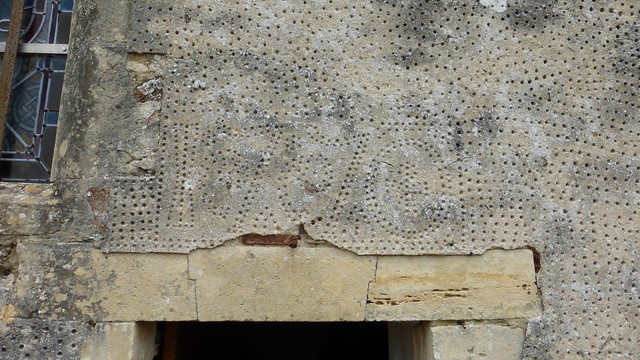 The exterior of the church is covered with a coating dated 1770 above the northern portal. This type of coating is meant to protect the walls from moisture which is not uncommon with churches in the area. The coating, moreover, is decorated with naive drawings created by masons.
The exterior of the church is covered with a coating dated 1770 above the northern portal. This type of coating is meant to protect the walls from moisture which is not uncommon with churches in the area. The coating, moreover, is decorated with naive drawings created by masons. 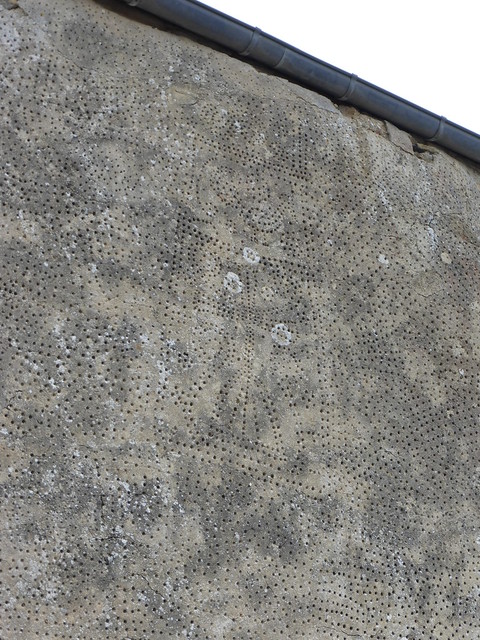
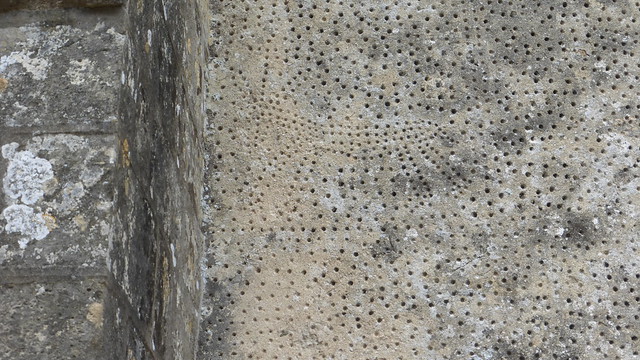 In some cases, it is easy to recognize, among others, a cross or a human figure and a bit to the right, an animal resembling a deer. Along the walls are several old tombstones and even one tomb belonging to a former military officer and friend to the poor of Crasville, Felix François Dursus (1746 – 1811).
In some cases, it is easy to recognize, among others, a cross or a human figure and a bit to the right, an animal resembling a deer. Along the walls are several old tombstones and even one tomb belonging to a former military officer and friend to the poor of Crasville, Felix François Dursus (1746 – 1811).
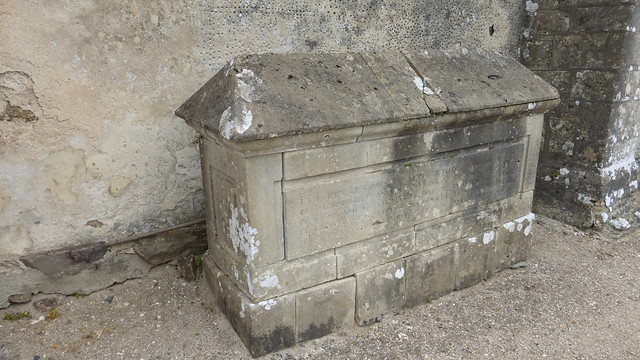
Published by The Baguette
-
in
Cotentin
July 1 2014
2
01
/07
/July
/2014
13:58
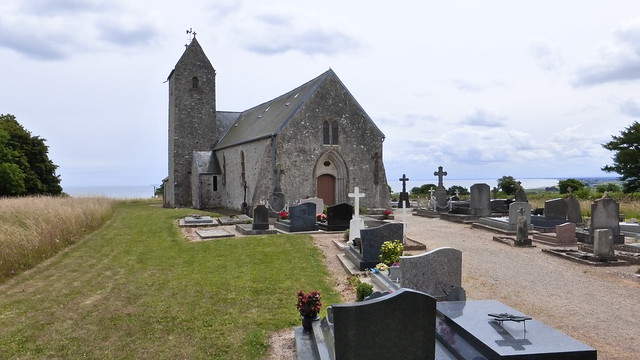
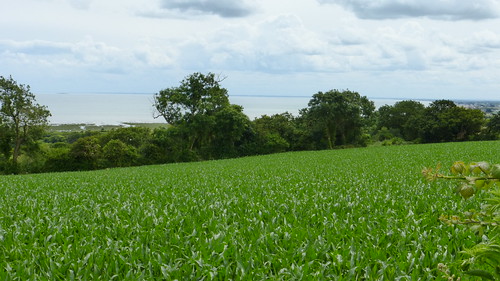 This small church is perched on a hill overlooking the Bay of Morsalines. The peace and quiet makes this a unique spot for meditation. The cemetery looks as grand as it is almost empty; but it is only an appearance. Indeed, it contains old graves from over fifteen centuries. One still finds from time to time Merovingian sarcophagi. This place of worship, one of the oldest of the Cotentin, was placed under the patronage of St-Anthony the Hermit, then later, Saint-Lubin de Chartres and now Notre Dame. The church was rebuilt in the 15th and 16th centuries. In the bell tower, one can see an arrow slit which probably dates from the 14th century. These embrasures enabled people taken refuge in churches to defend themselves against their aggressors. This was particularly common in villages that did not have a castle.
This small church is perched on a hill overlooking the Bay of Morsalines. The peace and quiet makes this a unique spot for meditation. The cemetery looks as grand as it is almost empty; but it is only an appearance. Indeed, it contains old graves from over fifteen centuries. One still finds from time to time Merovingian sarcophagi. This place of worship, one of the oldest of the Cotentin, was placed under the patronage of St-Anthony the Hermit, then later, Saint-Lubin de Chartres and now Notre Dame. The church was rebuilt in the 15th and 16th centuries. In the bell tower, one can see an arrow slit which probably dates from the 14th century. These embrasures enabled people taken refuge in churches to defend themselves against their aggressors. This was particularly common in villages that did not have a castle. 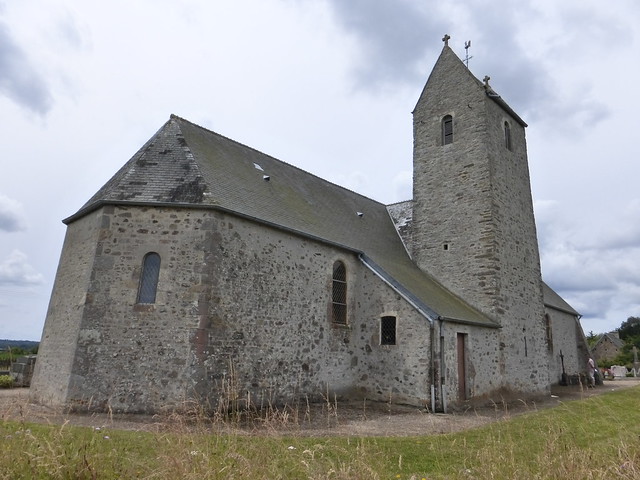 The observation of the exterior walls shows that the church originally included up to six side chapels which probably were funerary chapels. Three of these remain.
The observation of the exterior walls shows that the church originally included up to six side chapels which probably were funerary chapels. Three of these remain. 
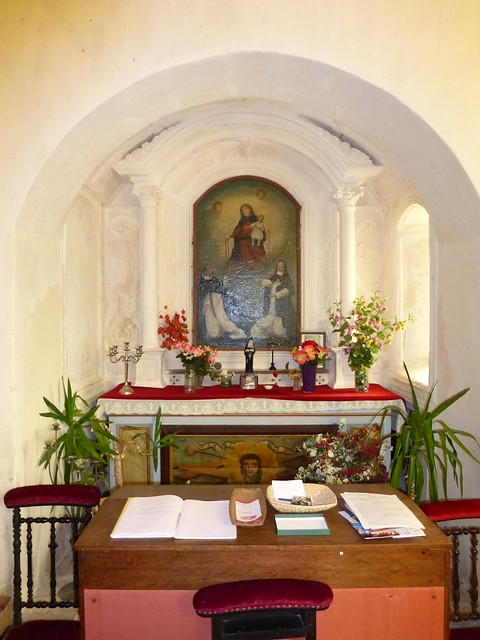
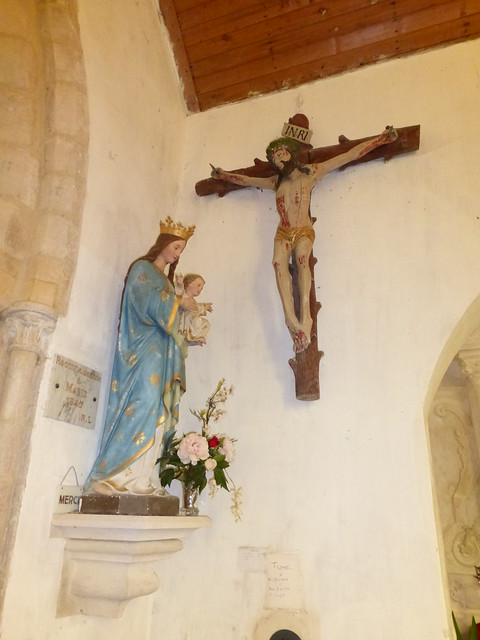
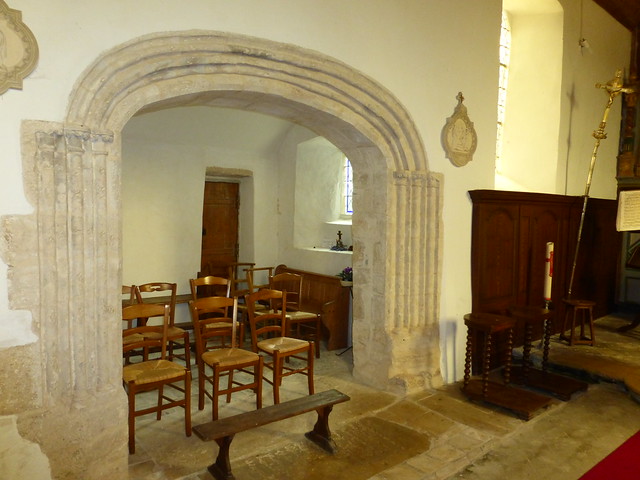 Two are located before the choir while the third one is just under the bell tower and no longer used.
Two are located before the choir while the third one is just under the bell tower and no longer used. 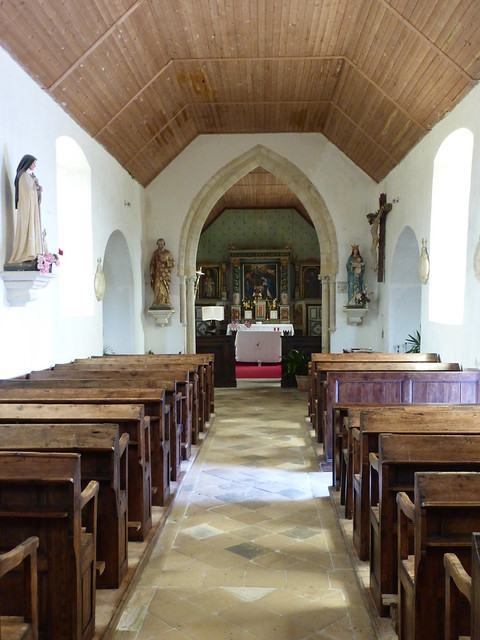 The crucifix, now hanging on the wall, was actually part of a rood beam that was once above the choir. It dates from the 15th century.
The crucifix, now hanging on the wall, was actually part of a rood beam that was once above the choir. It dates from the 15th century. 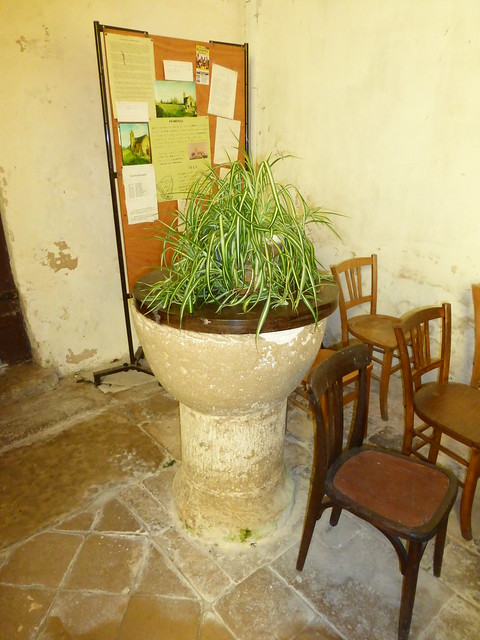 Like many other churches in the region, the baptismal font can be found in the western portion of the church--in this case, just near the main portal.
Like many other churches in the region, the baptismal font can be found in the western portion of the church--in this case, just near the main portal. 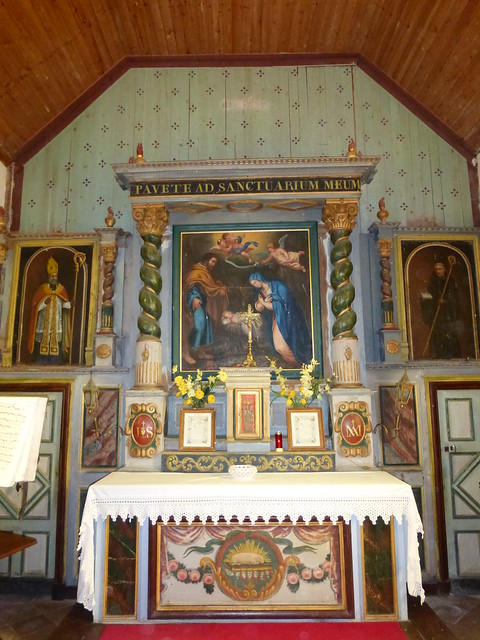 The high altar is really something to see. Although it isn't greatly ornamental, it has a charm all of its own with an oil painting depicting the Nativity just above the tabernacle.
The high altar is really something to see. Although it isn't greatly ornamental, it has a charm all of its own with an oil painting depicting the Nativity just above the tabernacle. 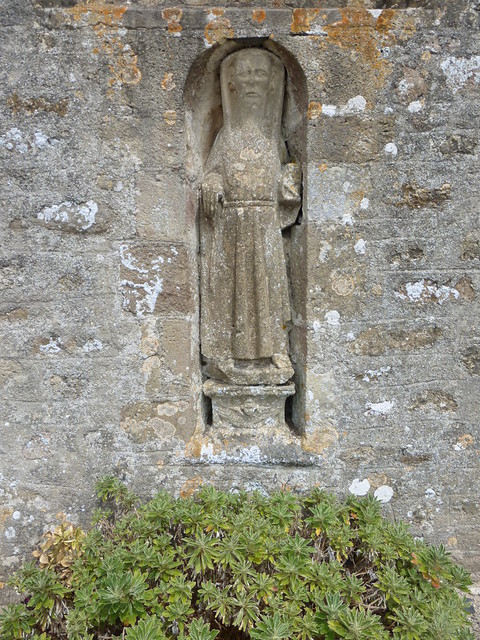 This stone statue of St-Anthony the Hermit is encased directly in the wall of the sanctuary along the north side of the church. Born in the middle of the 3rd century in Upper Egypt, he retired early to the desert where the devil tried several times and in different forms to tempt him away from his faith. Anthony resisted. Later, he welcomed disciples who wished to join him and live ascetic life in the desert. But the taste of solitude once more overtook him and he left his followers for another solitary life in the desert near the Red Sea where he lived until the age of 100. Over the centuries Anthony the Hermit has become a holy healer. He was invoked against the plague, leprosy, scabies and venereal diseases. His healing power also had an effect on animals, including pigs and horses. He is generally depicted as an old man wearing a frock with a cap bearing the Greek letter Tau and sometimes a bell. He is very often accompanied by a pig (an evil boar that he domesticated).
This stone statue of St-Anthony the Hermit is encased directly in the wall of the sanctuary along the north side of the church. Born in the middle of the 3rd century in Upper Egypt, he retired early to the desert where the devil tried several times and in different forms to tempt him away from his faith. Anthony resisted. Later, he welcomed disciples who wished to join him and live ascetic life in the desert. But the taste of solitude once more overtook him and he left his followers for another solitary life in the desert near the Red Sea where he lived until the age of 100. Over the centuries Anthony the Hermit has become a holy healer. He was invoked against the plague, leprosy, scabies and venereal diseases. His healing power also had an effect on animals, including pigs and horses. He is generally depicted as an old man wearing a frock with a cap bearing the Greek letter Tau and sometimes a bell. He is very often accompanied by a pig (an evil boar that he domesticated).
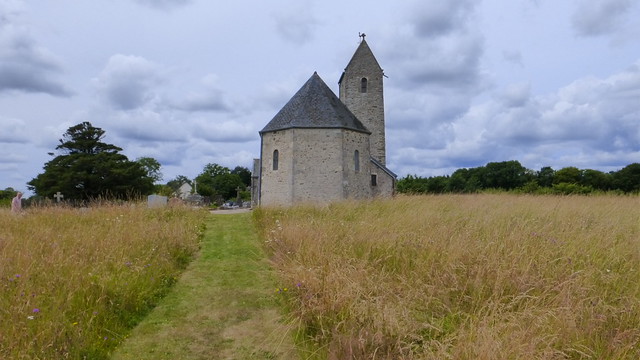
Published by The Baguette
-
in
Le Val de Saire
June 30 2014
1
30
/06
/June
/2014
09:19
Another beautiful weekend in La Manche ! Lots of sunshine and warm temperatures. On Saturday, I went for another short hike around the town of Lestre. 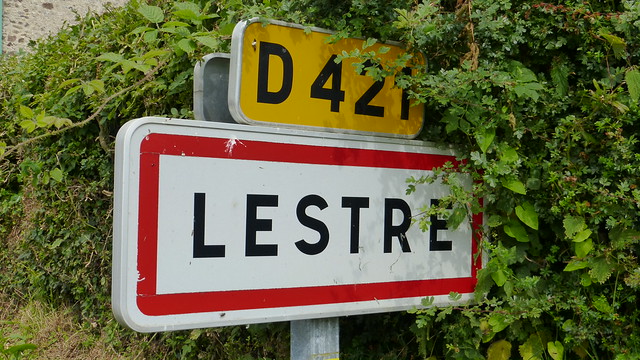 This particular hike was called Randonnée le circuit du Bouillon which roughly translates as the walk around the boiling rapids--an interesting name since there are no rapids to be seen along the streams you have to cross and they are certainly not boiling.
This particular hike was called Randonnée le circuit du Bouillon which roughly translates as the walk around the boiling rapids--an interesting name since there are no rapids to be seen along the streams you have to cross and they are certainly not boiling. 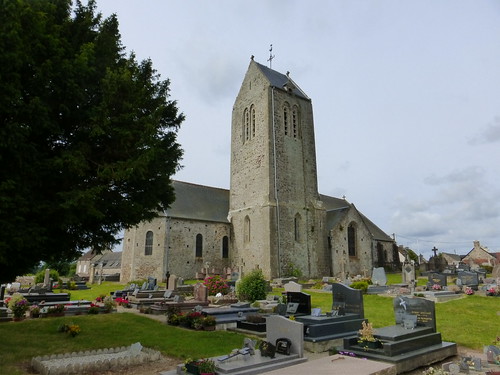
 The hike begins in Lestre at the foot of the church of St-Martin, with a typical Normandy saddleback bell tower and doorways that date from the 13th century.
The hike begins in Lestre at the foot of the church of St-Martin, with a typical Normandy saddleback bell tower and doorways that date from the 13th century. 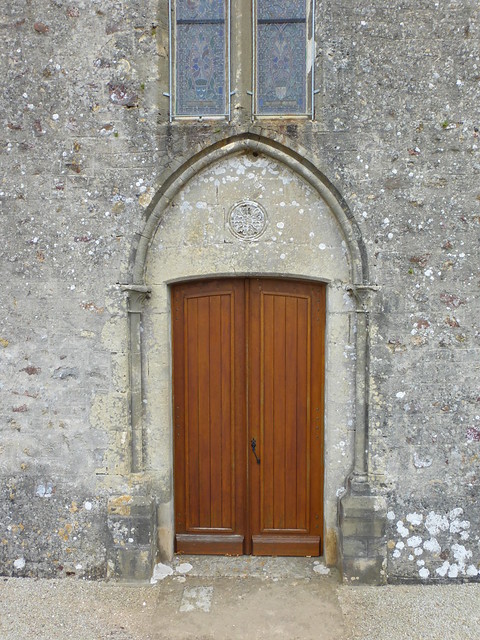
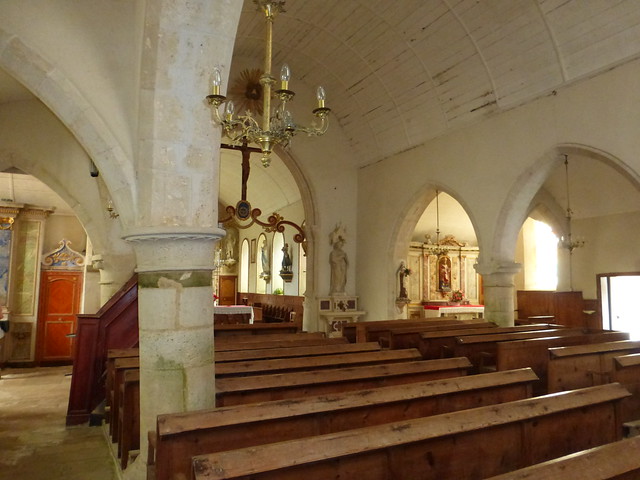 Inside is a triple aisle nave with two side chapels.
Inside is a triple aisle nave with two side chapels. 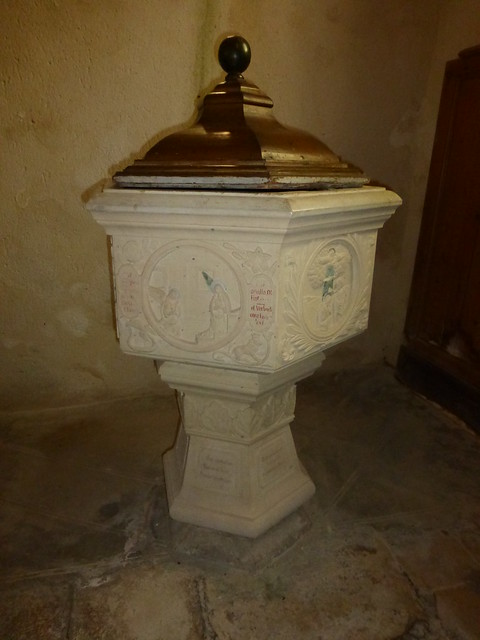 I thought the baptismal font was one of the most interesting pieces since it was intricately carved and adorned with quotes from the Bible.
I thought the baptismal font was one of the most interesting pieces since it was intricately carved and adorned with quotes from the Bible. 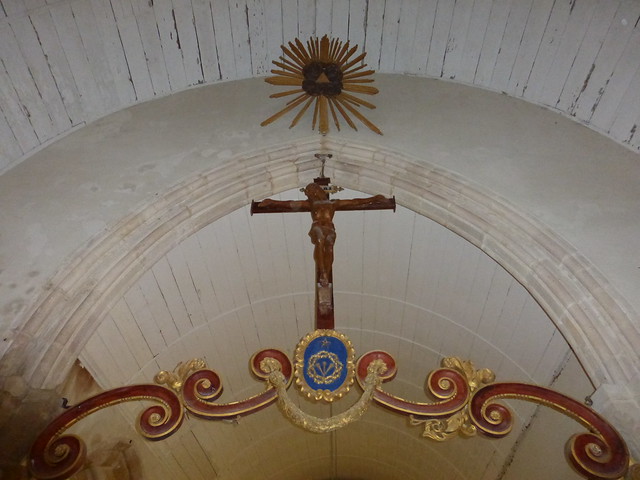 Above the choir is a “pouter de gloire” or rood screen which separates the main altar from the rest of the church.
Above the choir is a “pouter de gloire” or rood screen which separates the main altar from the rest of the church. 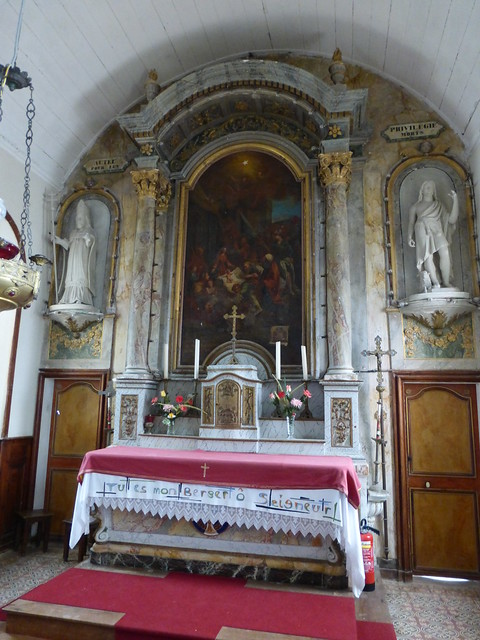 Above the main altar is a wonderful oil painting of the Three Wise Men at the Nativity. On either side are statues of Saint-Martin and Saint John the Baptist.
Above the main altar is a wonderful oil painting of the Three Wise Men at the Nativity. On either side are statues of Saint-Martin and Saint John the Baptist. 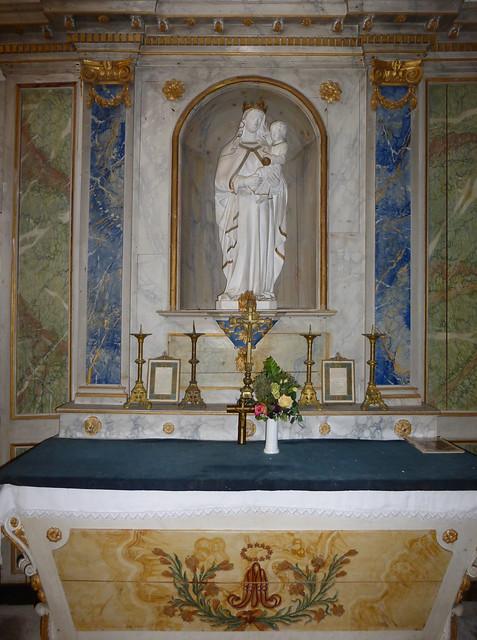
 I couldn’t find any more information about the church but as you can see, it has several nice chapels: one dedicated to the Virgin and another to Saint-Martin.
I couldn’t find any more information about the church but as you can see, it has several nice chapels: one dedicated to the Virgin and another to Saint-Martin. 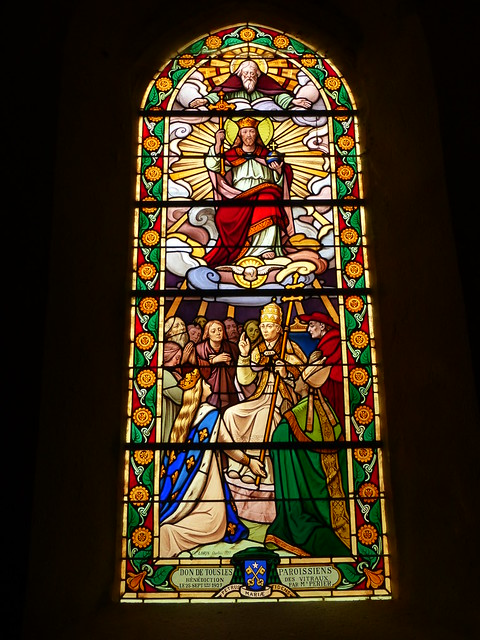 There is also a stained glass window from 1927 created in the workshops of Charles Lorin from Chartes.
There is also a stained glass window from 1927 created in the workshops of Charles Lorin from Chartes. 
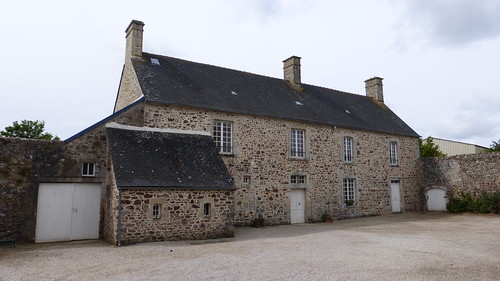 Across the street is the hôtel de ville with its newly restored arches.
Across the street is the hôtel de ville with its newly restored arches. 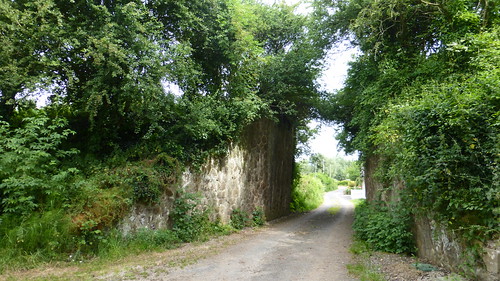
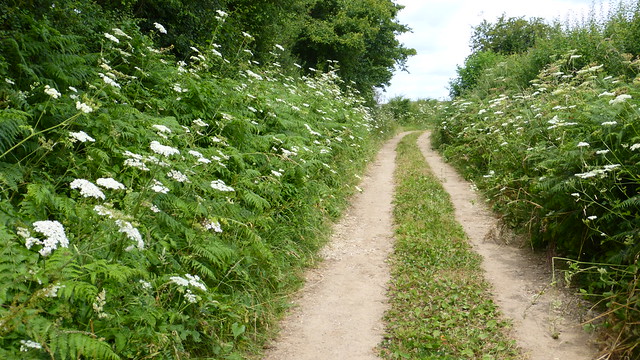 The hiking path takes you through farmers’ fields along poorly kept paths lined with wildflowers and weeds.
The hiking path takes you through farmers’ fields along poorly kept paths lined with wildflowers and weeds. 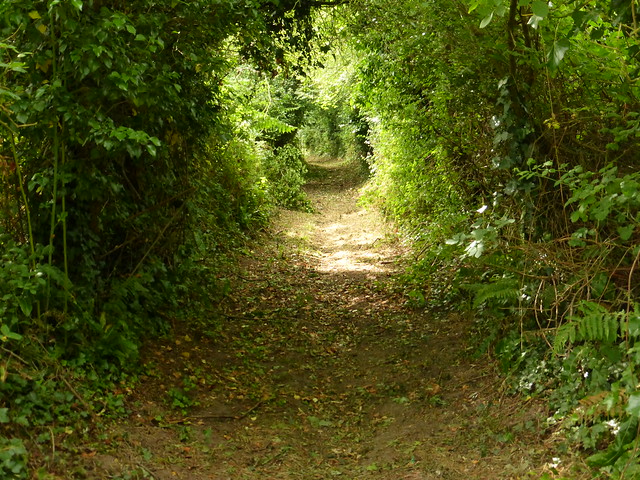

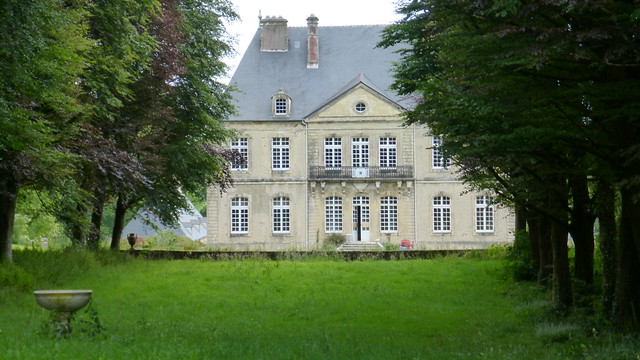 At times, one can get a fairly decent view of the Tourville castle, a private residence built in the 18th century by Jean-Louis Avice de Tourville .
At times, one can get a fairly decent view of the Tourville castle, a private residence built in the 18th century by Jean-Louis Avice de Tourville . 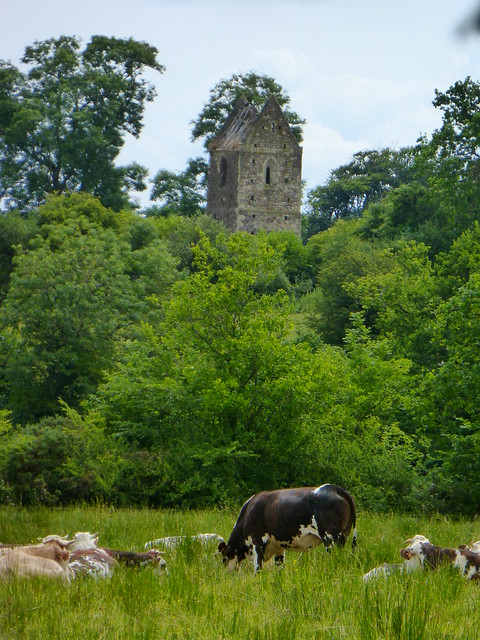
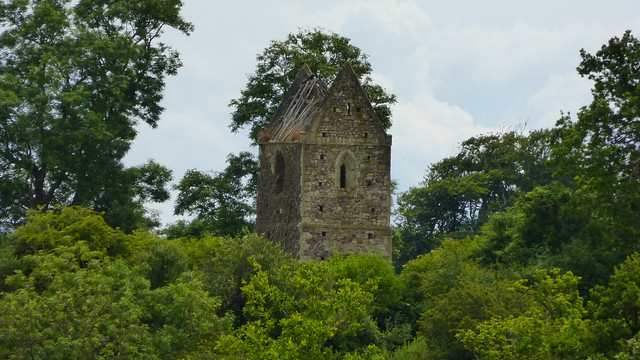 Just 400 meters away along a path marked private property is the most important motte féodale (motte-and-bailey castle) in Normandy. It dates from the 10th century and is in need of some restoration—the roof has collapsed and it is covered with vines.
Just 400 meters away along a path marked private property is the most important motte féodale (motte-and-bailey castle) in Normandy. It dates from the 10th century and is in need of some restoration—the roof has collapsed and it is covered with vines. 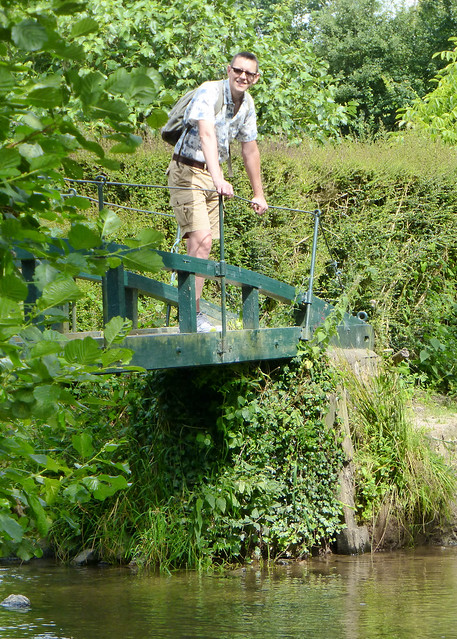 At one point, you have to cross a river called la Sinope which empties into the sea at Quinéville.
At one point, you have to cross a river called la Sinope which empties into the sea at Quinéville.  Just beside the passerelle is another stone bridge which was also marked as private property.
Just beside the passerelle is another stone bridge which was also marked as private property. 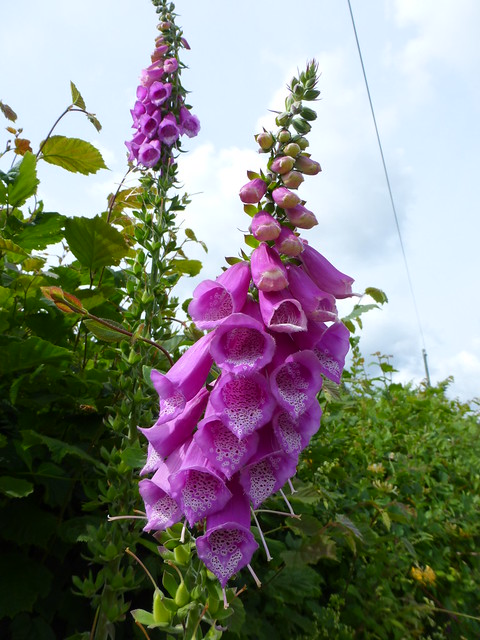 It is still too early in the summer to see roadways and country lanes full of foxglove, but there are a few areas where they are starting to bloom.
It is still too early in the summer to see roadways and country lanes full of foxglove, but there are a few areas where they are starting to bloom. 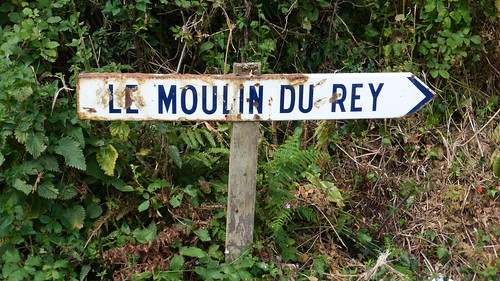
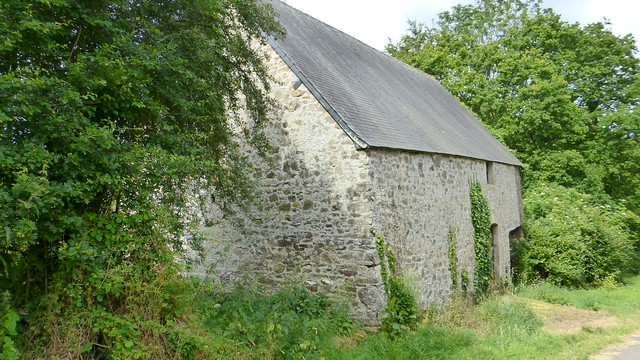

 Passing the Moulin de Rey, there are several old manor houses and stone farm buildings.
Passing the Moulin de Rey, there are several old manor houses and stone farm buildings. 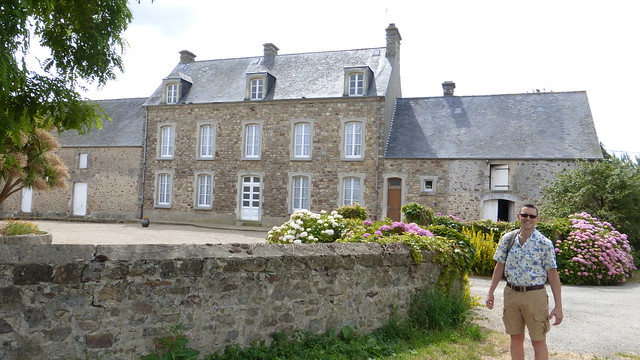 What do you think of my new shirt ? I bought it on Friday at H&M during sales week--got a whole new summer wardrobe for under 90 Euros !
What do you think of my new shirt ? I bought it on Friday at H&M during sales week--got a whole new summer wardrobe for under 90 Euros ! 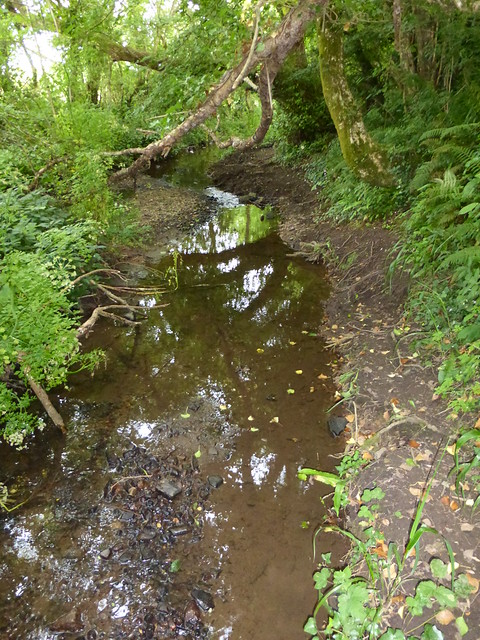 The trickiest part of the walk is a 200 meter stretch along the la Sinope where the path is actually just a trek along the riverside through mud and overgrown shrubs.
The trickiest part of the walk is a 200 meter stretch along the la Sinope where the path is actually just a trek along the riverside through mud and overgrown shrubs.  This last bridge is called le pont bleu but its name has nothing to do with the color blue. By the time I finished walking, it was almost 2pm and I was getting rather hungry. Fortunately, I packed a lunch with me and decided to drive to the old ruins of the Chapelle St-Michel where I sat and had my lunch.
This last bridge is called le pont bleu but its name has nothing to do with the color blue. By the time I finished walking, it was almost 2pm and I was getting rather hungry. Fortunately, I packed a lunch with me and decided to drive to the old ruins of the Chapelle St-Michel where I sat and had my lunch. 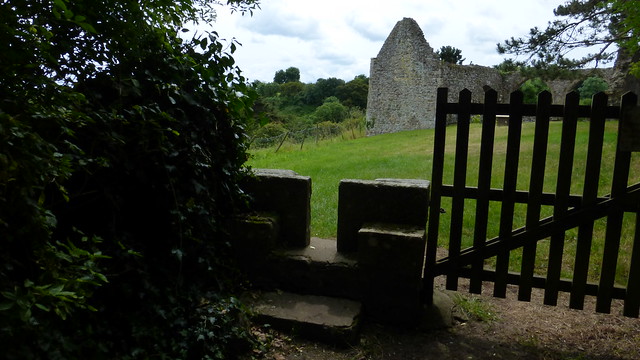 The chapel of Saint-Michel is actually a ruin from the first third of the 12th century.
The chapel of Saint-Michel is actually a ruin from the first third of the 12th century.  The chapel depended on the abbey of Blanchelande and was first mentioned in writings from 1160.
The chapel depended on the abbey of Blanchelande and was first mentioned in writings from 1160. 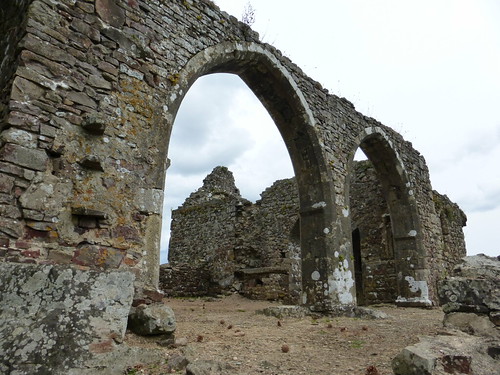
 After the French Revolution, it was sold and its remaining stones were looted.
After the French Revolution, it was sold and its remaining stones were looted. 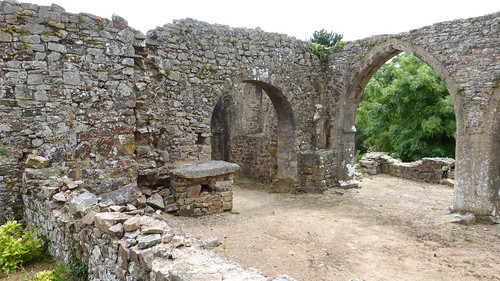
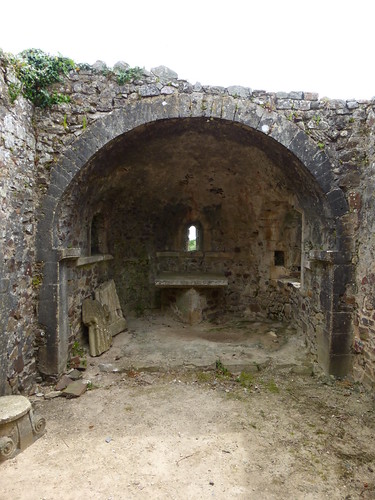

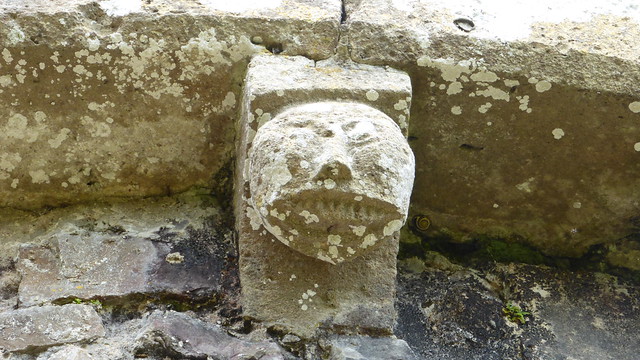 The apse decorated with corbels of animal and human faces.
The apse decorated with corbels of animal and human faces. 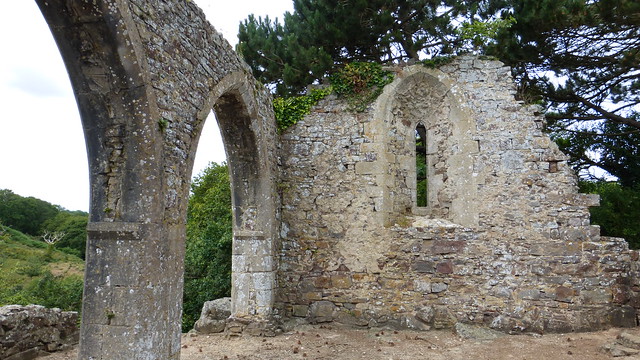 These are two of the broken arches that formed the aisle.
These are two of the broken arches that formed the aisle. 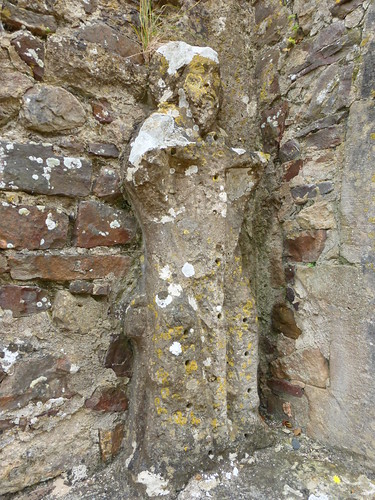 This is a statue of the Holy Trinity. Within the transept is a Gothic chapel with several statues including those of St-Côme and St-Damien as well as a recumbent effigy along one of the walls.
This is a statue of the Holy Trinity. Within the transept is a Gothic chapel with several statues including those of St-Côme and St-Damien as well as a recumbent effigy along one of the walls. 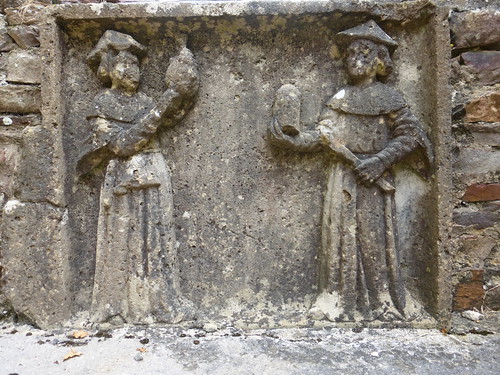
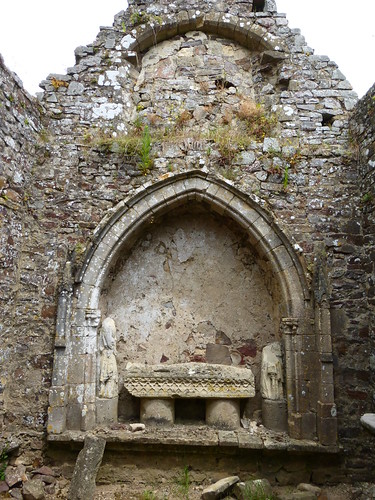 Other statues are only fragments such as this one of St-Jacques.
Other statues are only fragments such as this one of St-Jacques. 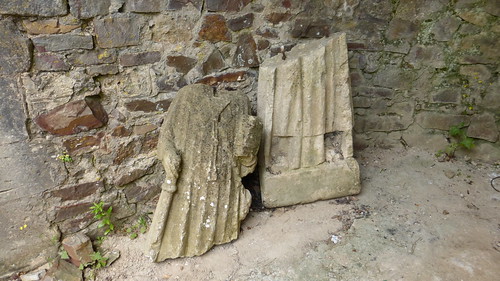
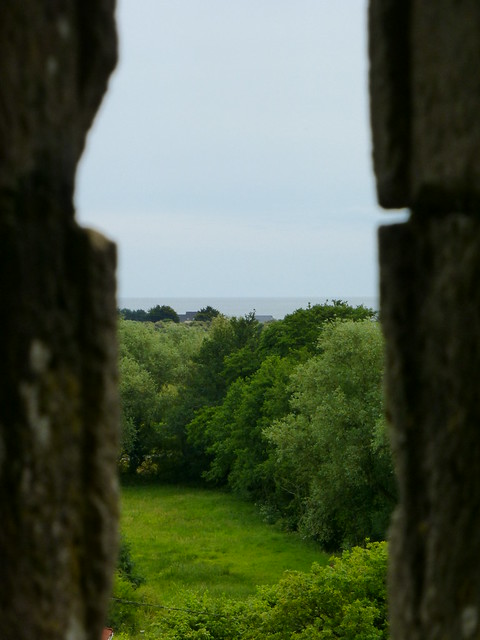 Through a small window in the apse, one has a good view of the sea. This same window is formed with stones laid out in a pattern called arête-de-poisson, or fish bones.
Through a small window in the apse, one has a good view of the sea. This same window is formed with stones laid out in a pattern called arête-de-poisson, or fish bones.

Published by The Baguette
-
in
Cotentin
June 29 2014
7
29
/06
/June
/2014
17:07
After a day of hiking and then a visit to the German gun batteries, I then drove to Montebourg to visit the Abbaye Sainte-Marie. Strangely enough I've never been there even though it's so close to Cherbourg. 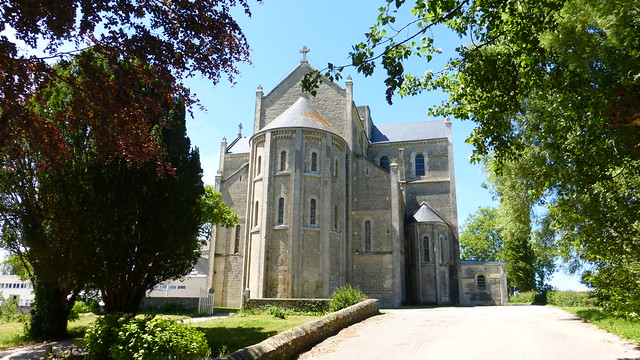

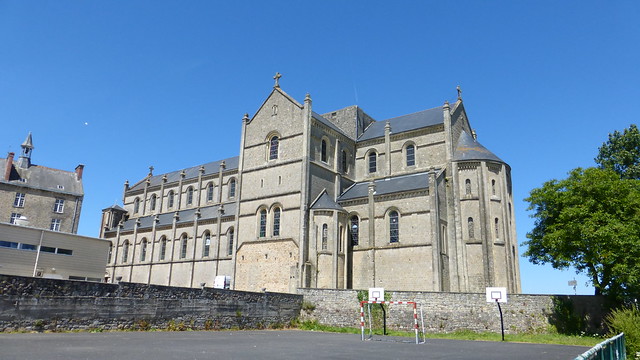 The origins of the abbey can be traced back to William the Conqueror in the second half of the 11th century but its legendary beginnings are a lot more interesting, albeit a lot more far-fetched (read it for yourself... I don't think it would be a miracle if someone came ashore in a boat one morning, would you ?) Anyway, the legend, written down in the 15th century, tells of two monks from the Savoie who spent the night on a Normandy beach. One of them (no name given) decided to sleep in a boat that had washed up on the shore; the second, Roger, preferred to sleep on the beach.
The origins of the abbey can be traced back to William the Conqueror in the second half of the 11th century but its legendary beginnings are a lot more interesting, albeit a lot more far-fetched (read it for yourself... I don't think it would be a miracle if someone came ashore in a boat one morning, would you ?) Anyway, the legend, written down in the 15th century, tells of two monks from the Savoie who spent the night on a Normandy beach. One of them (no name given) decided to sleep in a boat that had washed up on the shore; the second, Roger, preferred to sleep on the beach. 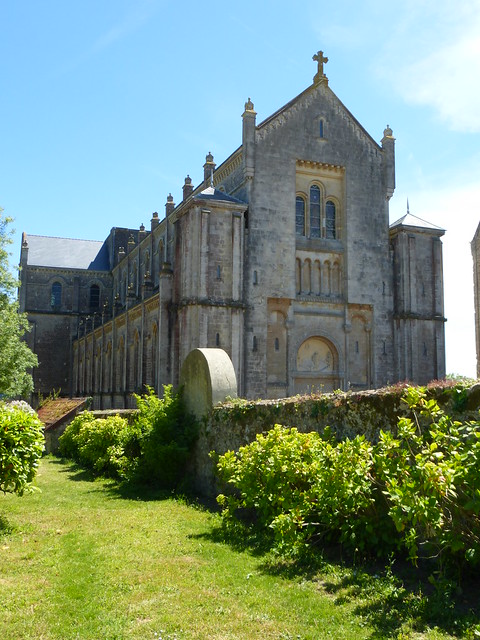
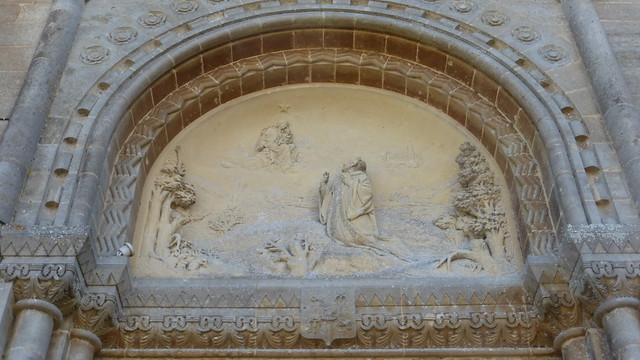
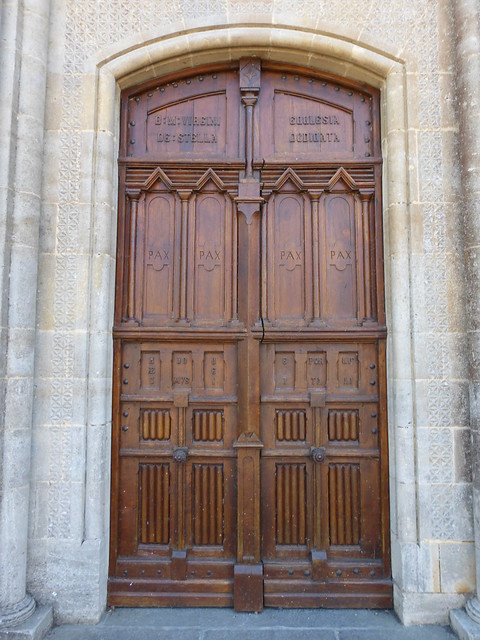 The tide carried the boat and its occupant all the way to the English coast where he was elected bishop by the people who were stunned by this "miracle". In Normandy the next morning, Roger went in search of his companion who disappeared. Tired, he stopped one night at the foot of a hill in Montebourg. He fell asleep and dreamt that a star had fallen on top of the hill. The Virgin appeared to him and told him that he must build a chapel there in her honor. Upon hearing of these events, Duke William gave Roger land, materials and various rights in the forests of the Cotentin in order for Roger to build his monastery. The abbaye de Montebourg was consecrated only in 1152, in the presence of the Archbishop of Rouen Hugh of Amiens, the bishops of Coutances and Evreux, and local lords, including Guillaume de Vernon, patron and protector of the abbey. The buildings were destroyed during and after the French Revolution, but the church was rebuilt in neo-Romanesque style between 1892 and 1933. Today, the abbey buildings are occupied by a private agricultural junior high and high school.
The tide carried the boat and its occupant all the way to the English coast where he was elected bishop by the people who were stunned by this "miracle". In Normandy the next morning, Roger went in search of his companion who disappeared. Tired, he stopped one night at the foot of a hill in Montebourg. He fell asleep and dreamt that a star had fallen on top of the hill. The Virgin appeared to him and told him that he must build a chapel there in her honor. Upon hearing of these events, Duke William gave Roger land, materials and various rights in the forests of the Cotentin in order for Roger to build his monastery. The abbaye de Montebourg was consecrated only in 1152, in the presence of the Archbishop of Rouen Hugh of Amiens, the bishops of Coutances and Evreux, and local lords, including Guillaume de Vernon, patron and protector of the abbey. The buildings were destroyed during and after the French Revolution, but the church was rebuilt in neo-Romanesque style between 1892 and 1933. Today, the abbey buildings are occupied by a private agricultural junior high and high school. 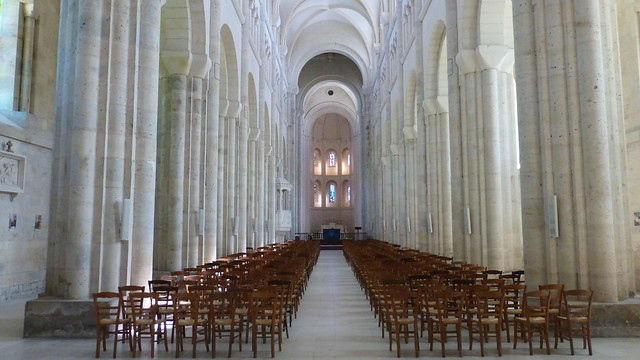
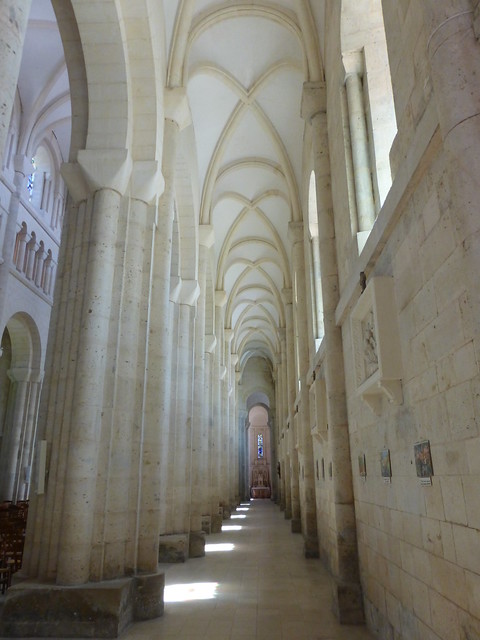
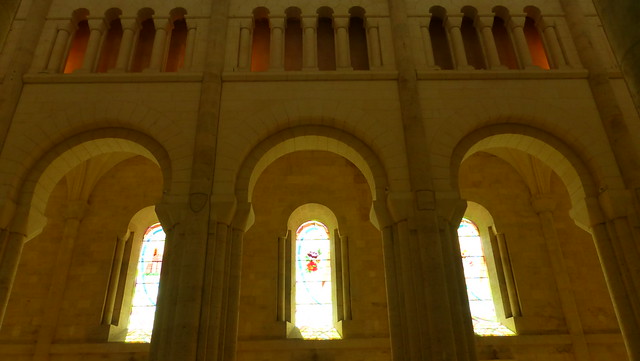
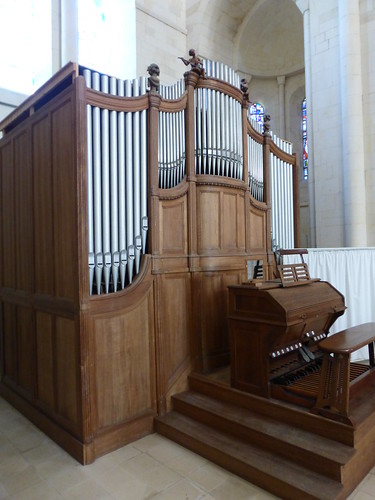 The interior is very clean and bathed in light from the stained glass installed in the 1950s.
The interior is very clean and bathed in light from the stained glass installed in the 1950s. 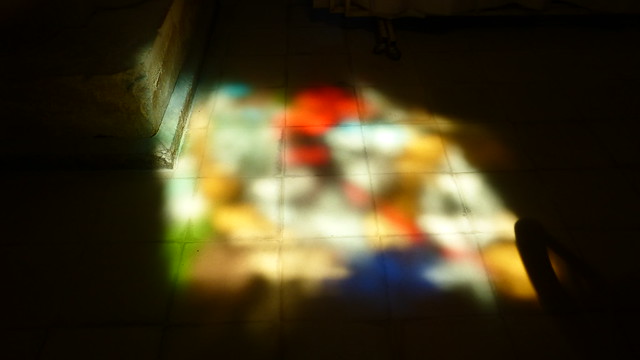
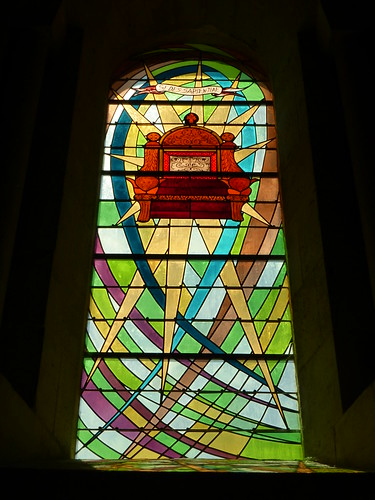
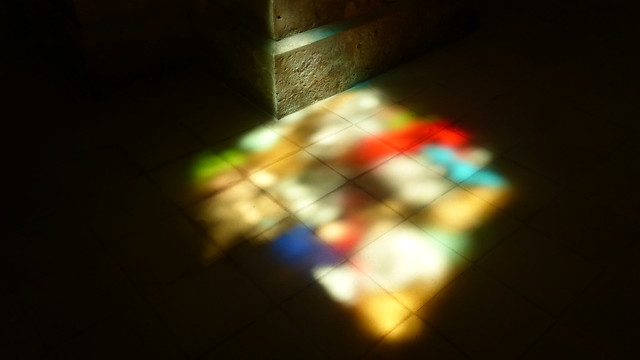
 There were so many splashes of color along the floors and walls. It isn't very often you see such a rainbow.
There were so many splashes of color along the floors and walls. It isn't very often you see such a rainbow. 
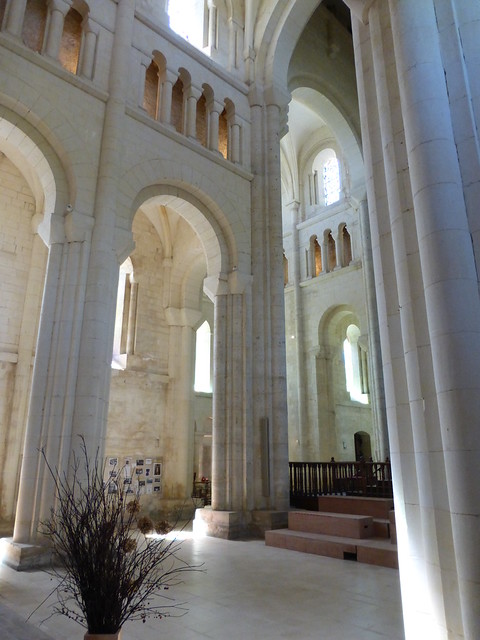
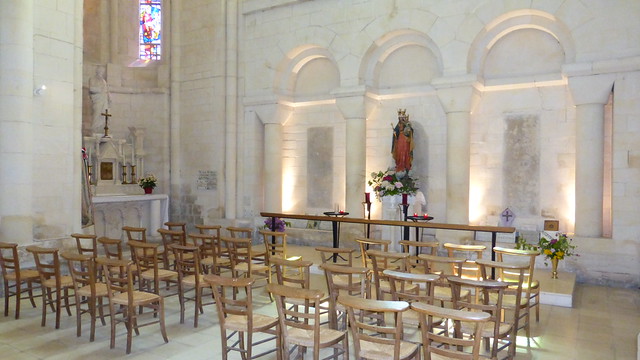
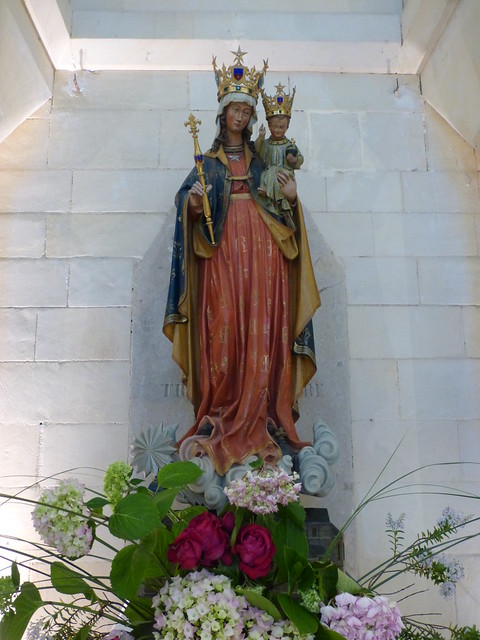 Along the norhtern wall is the chapel devoted to Notre-Dame de l'Étoile (Our Lady of the Star) where worshipers come to pray for world peace. After visiting the abbey and the grounds, I drove into the town to visit l'église Saint-Jacques. It was partially destroyed during World War II and there are still some bullet impacts along the exterior walls.
Along the norhtern wall is the chapel devoted to Notre-Dame de l'Étoile (Our Lady of the Star) where worshipers come to pray for world peace. After visiting the abbey and the grounds, I drove into the town to visit l'église Saint-Jacques. It was partially destroyed during World War II and there are still some bullet impacts along the exterior walls. 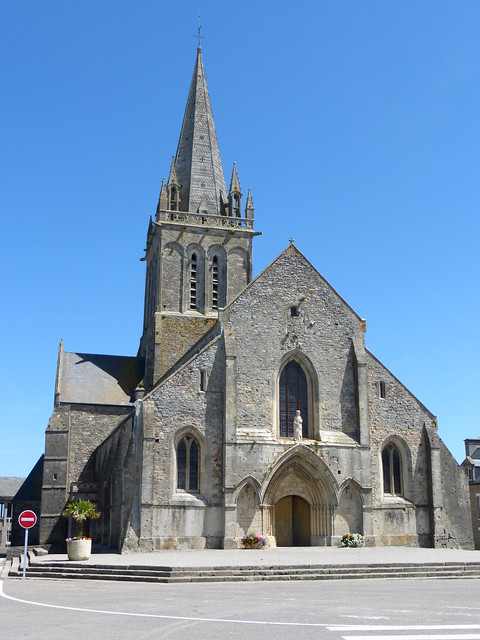 Its construction was decided upon by the Abbé de Montebourg at the beginning of the 15th century and it was consecrated on September 2, 1329 by the Bishop of Coutances, Guillaume de Thieuville. It is rather dark inside and there are a few things of interest to see.
Its construction was decided upon by the Abbé de Montebourg at the beginning of the 15th century and it was consecrated on September 2, 1329 by the Bishop of Coutances, Guillaume de Thieuville. It is rather dark inside and there are a few things of interest to see. 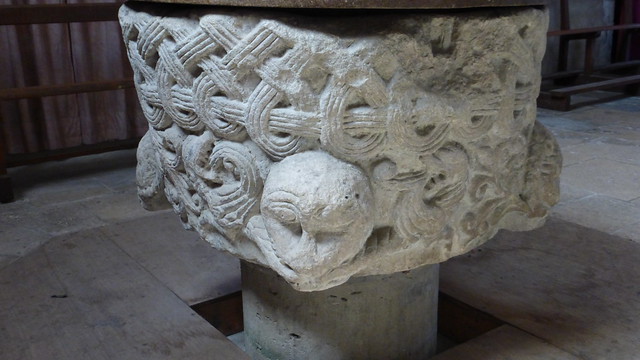 For starters, there is the baptismal font which is actually an old column capital adorned with animal faces and an intricate interlace pattern. It dates from the 11th century.
For starters, there is the baptismal font which is actually an old column capital adorned with animal faces and an intricate interlace pattern. It dates from the 11th century. 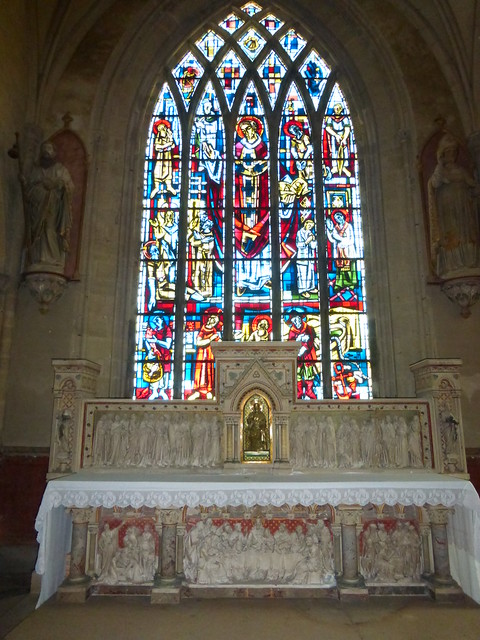 Behind the rather uninspired main altar is the original high altar adorned in bas-reliefs and backlit with a large stained glass window.
Behind the rather uninspired main altar is the original high altar adorned in bas-reliefs and backlit with a large stained glass window. 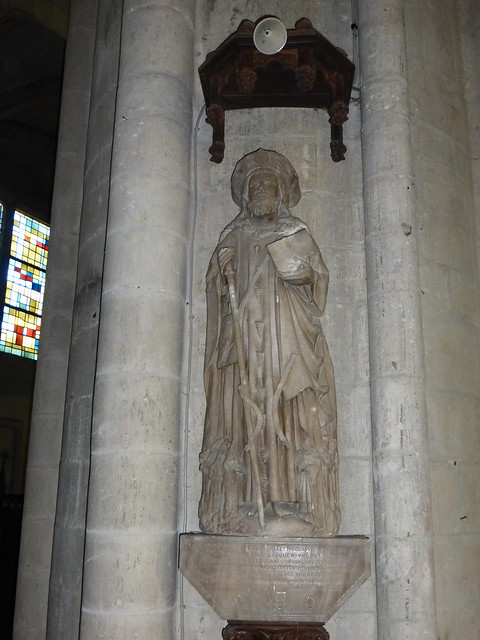 There is also a statue of St-Jacques in the choir from the 14th century.
There is also a statue of St-Jacques in the choir from the 14th century. 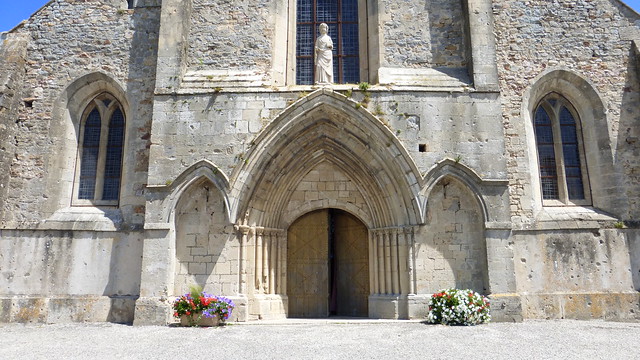 Another 14th century statue of St-Jacques stands outside above the portal to the church.
Another 14th century statue of St-Jacques stands outside above the portal to the church. 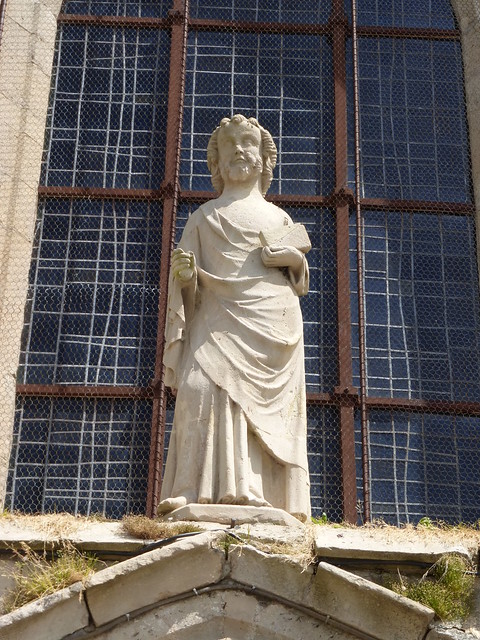 In July, there is a solemnity to the town's patron saint and the parishoners crown the statue with roses. To finish the day, I wanted to find a place that served ice cream but could only find a chocolate maker, Territoires Chocolats where everything could be tasted before buying. Wouldn't you know it, as I was driving out of town, I saw a sign for ice cream just outside of a resturant near the chocolatier--just another example of my luck (or lack of) in life.
In July, there is a solemnity to the town's patron saint and the parishoners crown the statue with roses. To finish the day, I wanted to find a place that served ice cream but could only find a chocolate maker, Territoires Chocolats where everything could be tasted before buying. Wouldn't you know it, as I was driving out of town, I saw a sign for ice cream just outside of a resturant near the chocolatier--just another example of my luck (or lack of) in life.

Published by The Baguette
-
in
Cotentin
 The reconstruction of the church after World War II led to the discovery of many sarcophagi underneath the foundations which show that Vesly was an important town with many influential people during the Merovingian and Carolingian times. Another cemetery of several sarcophagi is the necropolis that existed around the chapel of the Virgin located 300 meters north of the church. The church is cruciform with two side aisles but no ambulatory.
The reconstruction of the church after World War II led to the discovery of many sarcophagi underneath the foundations which show that Vesly was an important town with many influential people during the Merovingian and Carolingian times. Another cemetery of several sarcophagi is the necropolis that existed around the chapel of the Virgin located 300 meters north of the church. The church is cruciform with two side aisles but no ambulatory.  The transept however is very prominent and is marked with a triumphal arch above which is mounted an 18th century crucifix.
The transept however is very prominent and is marked with a triumphal arch above which is mounted an 18th century crucifix. 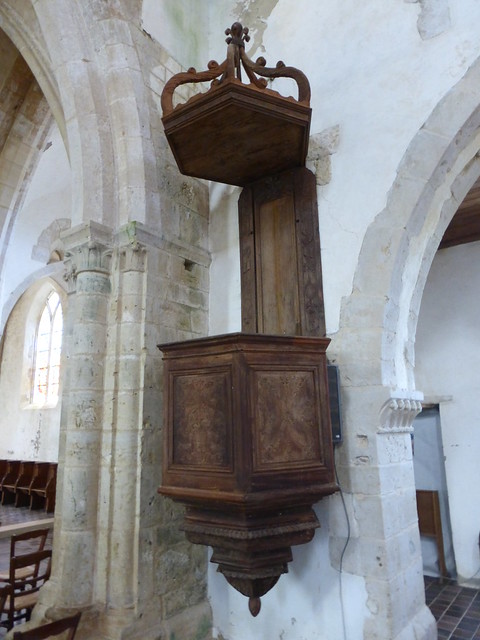 To the right of the arch is the wooden pulpit which dates from the 1720s.
To the right of the arch is the wooden pulpit which dates from the 1720s. 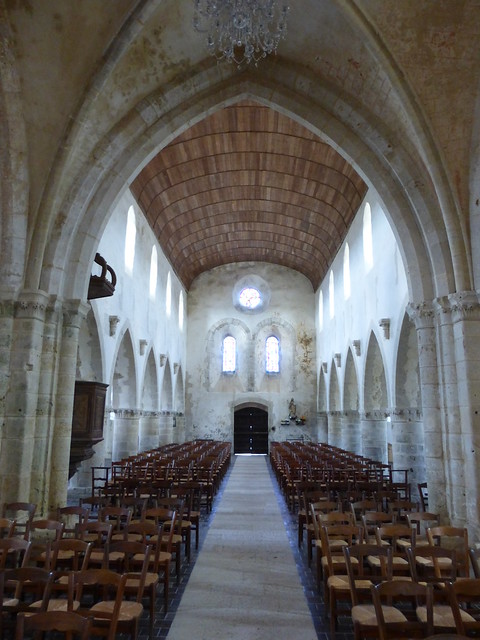
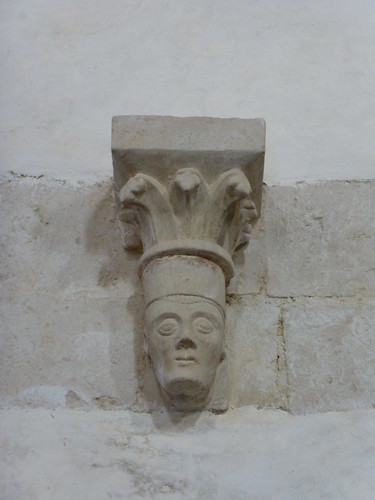
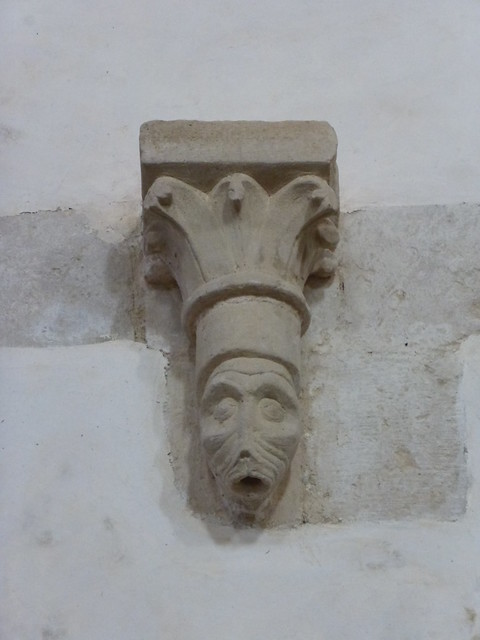 The nave and transept are 13th century as is the lower part of the bell tower. Be sure to check out the decorative heads along the nave. It is thought that these were once part of some vaulting that is now missing.
The nave and transept are 13th century as is the lower part of the bell tower. Be sure to check out the decorative heads along the nave. It is thought that these were once part of some vaulting that is now missing.  Outside, along the bell tower are some interesting corbels too that display some grotesque faces.
Outside, along the bell tower are some interesting corbels too that display some grotesque faces. 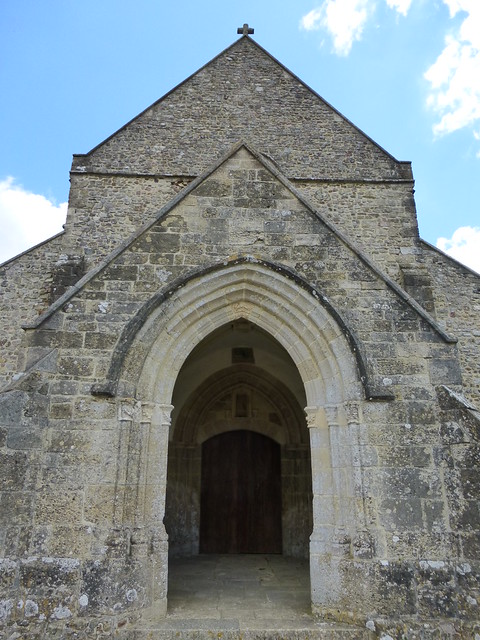 In 1472 the western porch was added and above the door is the following inscription: "The year of our Lord one thousand four hundred seventy-two this portal was made by and donated by nobleman Pierre Le Poupet. In his lifetime Lord of Besneville. God grant him paradise. Amen.”
In 1472 the western porch was added and above the door is the following inscription: "The year of our Lord one thousand four hundred seventy-two this portal was made by and donated by nobleman Pierre Le Poupet. In his lifetime Lord of Besneville. God grant him paradise. Amen.” 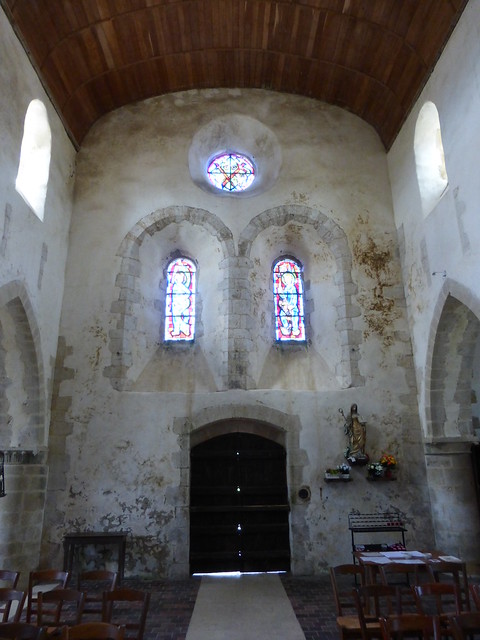 The west facade is illuminated by two, arched lancet windows topped by an oculus. These lancets are the oldest element of the church and date from the early 13th century. The oculus however is from the 15th.
The west facade is illuminated by two, arched lancet windows topped by an oculus. These lancets are the oldest element of the church and date from the early 13th century. The oculus however is from the 15th. 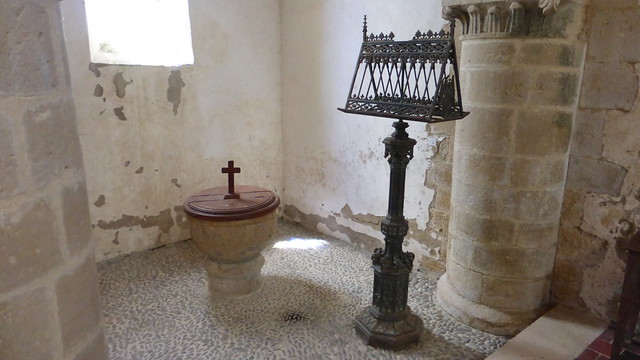 On the left of the main portal is the baptismal font made from limestone from Valognes as well as a Gothic style lectern.
On the left of the main portal is the baptismal font made from limestone from Valognes as well as a Gothic style lectern. 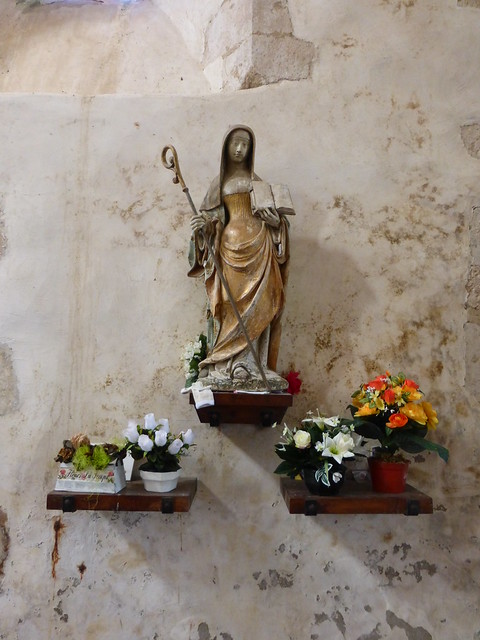 To the right of the main portal is the 16th century statue of Sainte-Walburge. This saint was widely venerated in the region and was invoked especially by mothers of sick children as well as sailors or those suffering from hydrophobia.
To the right of the main portal is the 16th century statue of Sainte-Walburge. This saint was widely venerated in the region and was invoked especially by mothers of sick children as well as sailors or those suffering from hydrophobia. 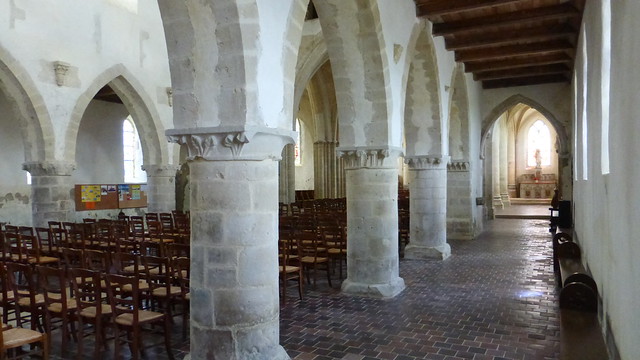 The arcades of five bays of the nave are supported by squat cylindrical columns that rest on square bases.
The arcades of five bays of the nave are supported by squat cylindrical columns that rest on square bases. 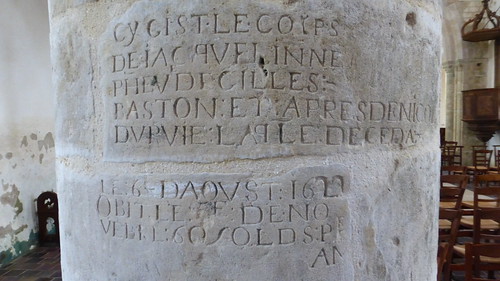 Some of them have Latin inscriptions from the 1600s.
Some of them have Latin inscriptions from the 1600s. 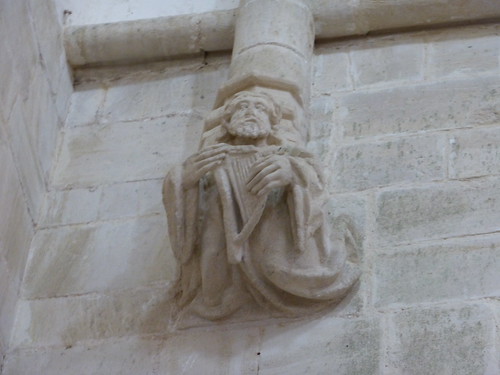
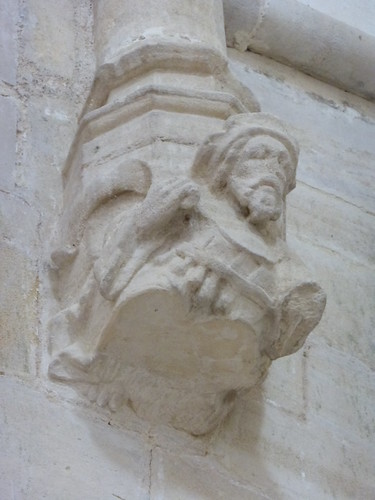
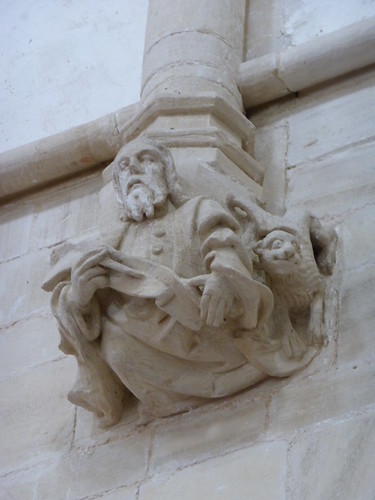 In the choir are six Renaissance style corbels which represent the four evangelists as well as the prophet Isaiah and King David.
In the choir are six Renaissance style corbels which represent the four evangelists as well as the prophet Isaiah and King David. 
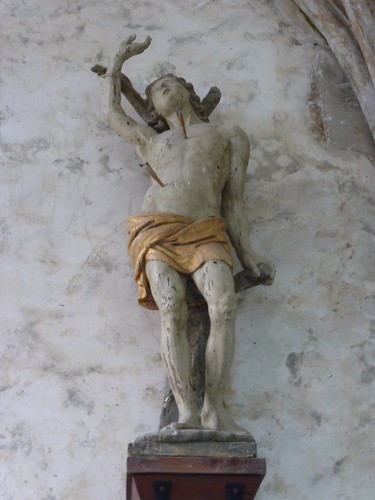 On either side of the main altar are two 18th century statues in polychrome wood of Saint-Nicolas and Saint-Sébastien.
On either side of the main altar are two 18th century statues in polychrome wood of Saint-Nicolas and Saint-Sébastien. 
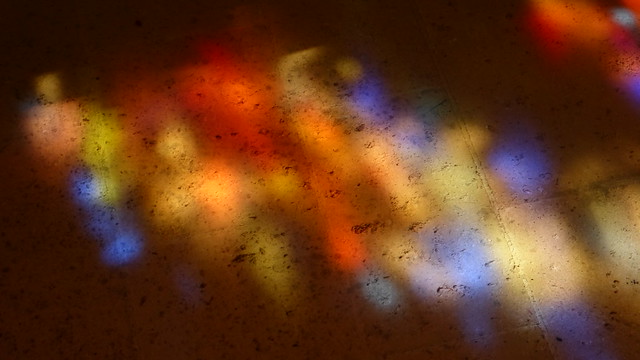 The stained glass was placed in the church during restorations after World War II and were designed by master glassmaker Hubert de Sainte-Marie. There is a small tower along the southern wall which makes up part of the transept.
The stained glass was placed in the church during restorations after World War II and were designed by master glassmaker Hubert de Sainte-Marie. There is a small tower along the southern wall which makes up part of the transept. 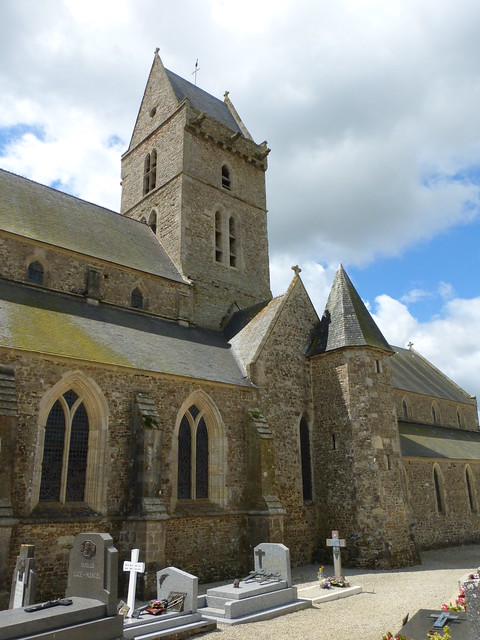 I can’t find any information about it but I’m pretty sure it is very old too.
I can’t find any information about it but I’m pretty sure it is very old too. 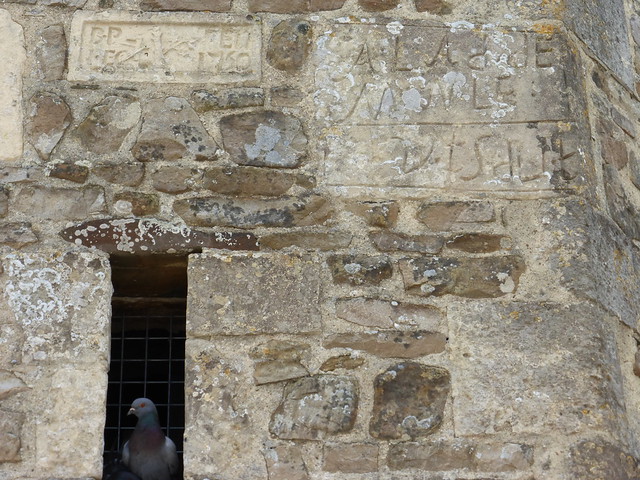 It even has some writing (which I can't make out) above one of the small lancet windows.
It even has some writing (which I can't make out) above one of the small lancet windows. 
